Use Of Ruthenium Complexes In Olefin Metathesis Reaction
SKOWERSKI; Krzysztof ; et al.
U.S. patent application number 16/348721 was filed with the patent office on 2019-09-26 for use of ruthenium complexes in olefin metathesis reaction. This patent application is currently assigned to APEIRON SYNTHESIS S.A.. The applicant listed for this patent is APEIRON SYNTHESIS S.A.. Invention is credited to Michal Pawel CHWALBA, Rafal GAWIN, Krzysztof SKOWERSKI.
| Application Number | 20190291089 16/348721 |
| Document ID | / |
| Family ID | 62110452 |
| Filed Date | 2019-09-26 |
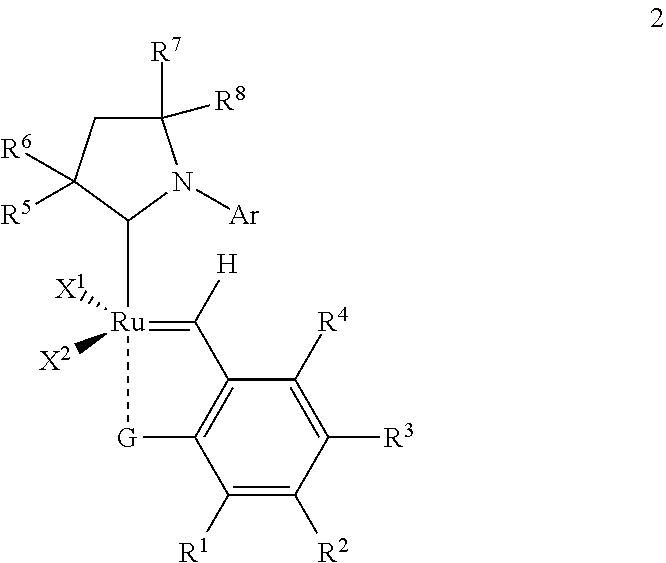



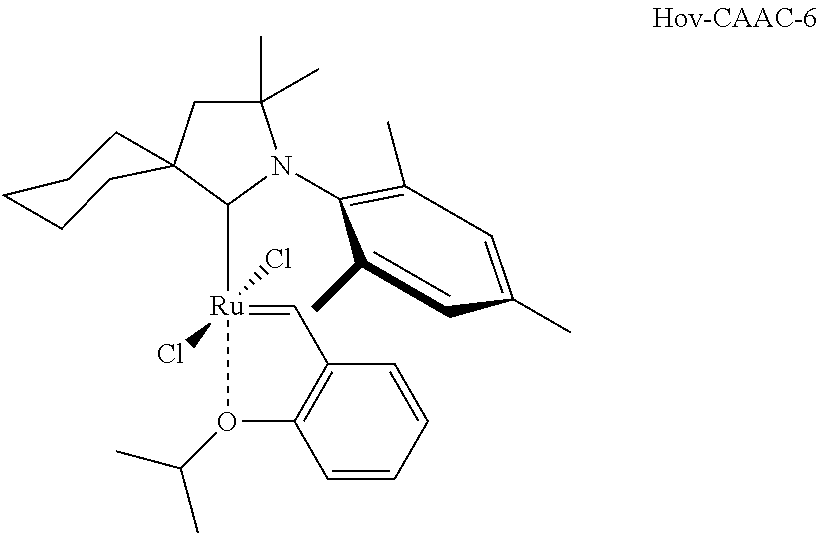
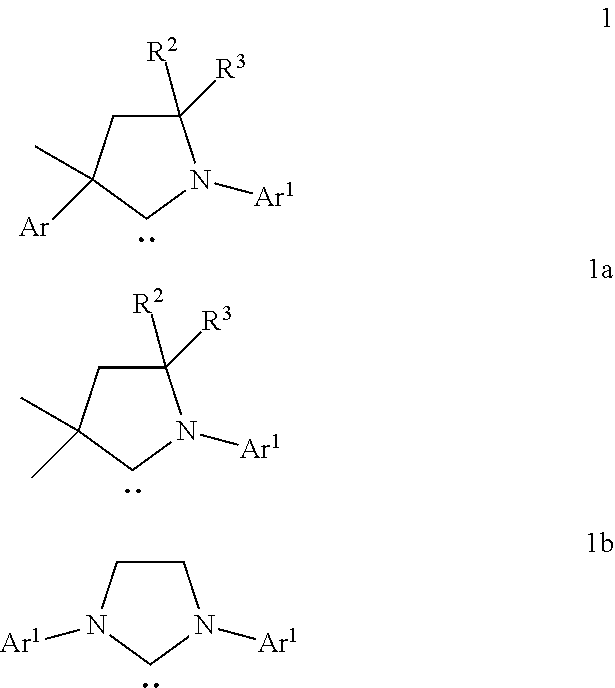

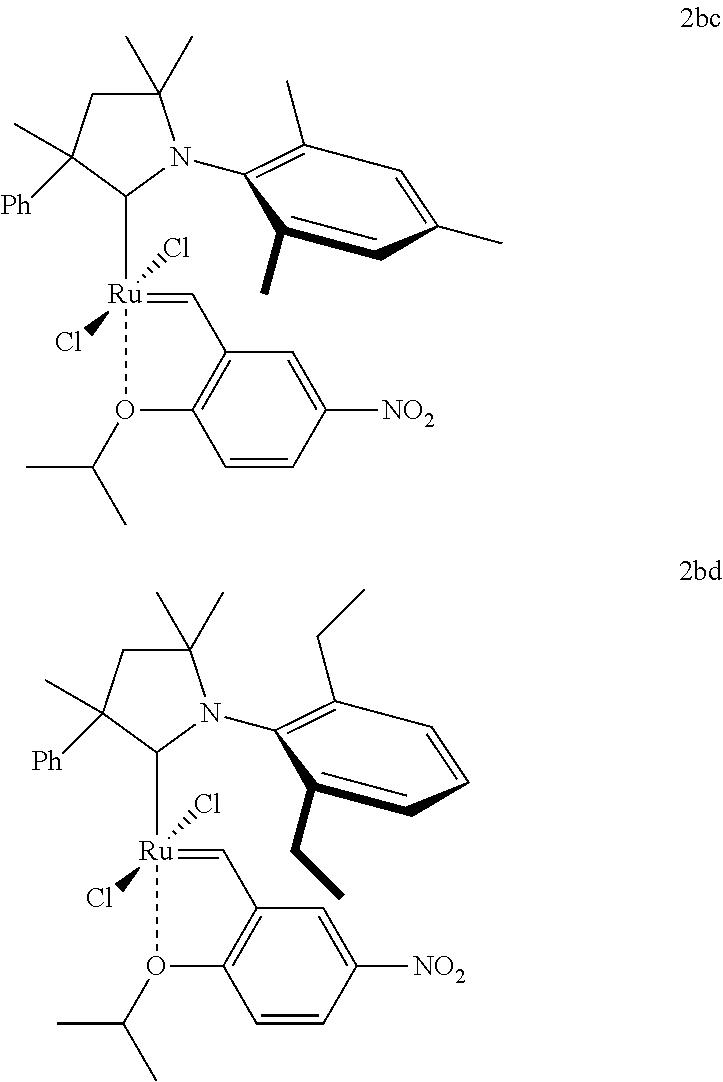
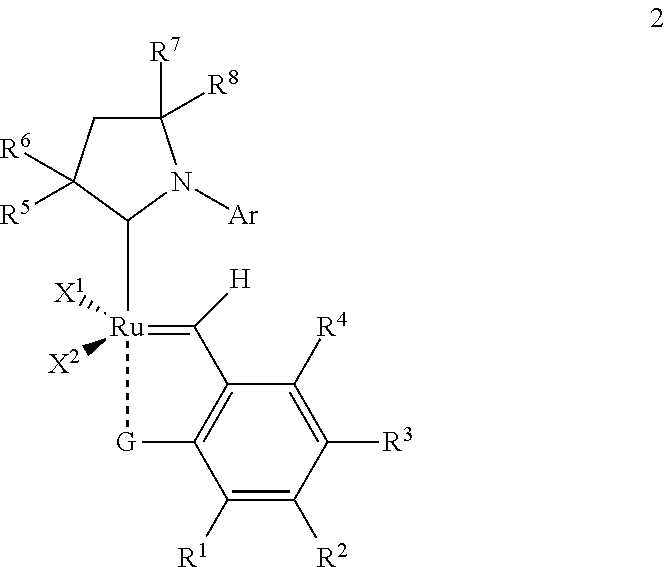
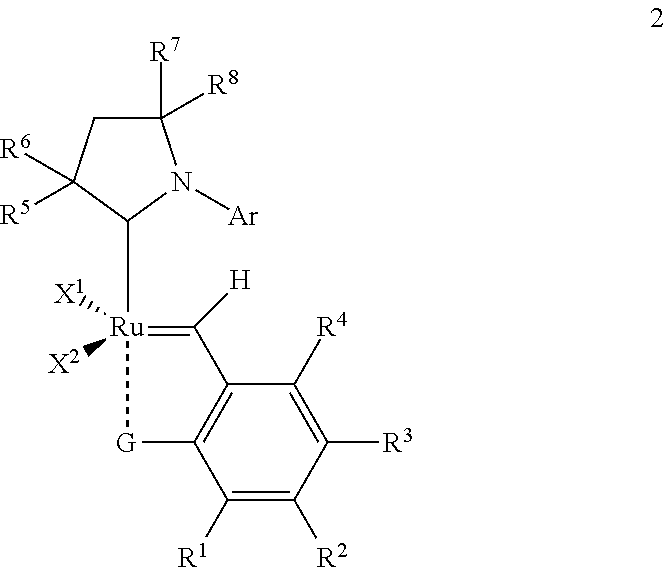
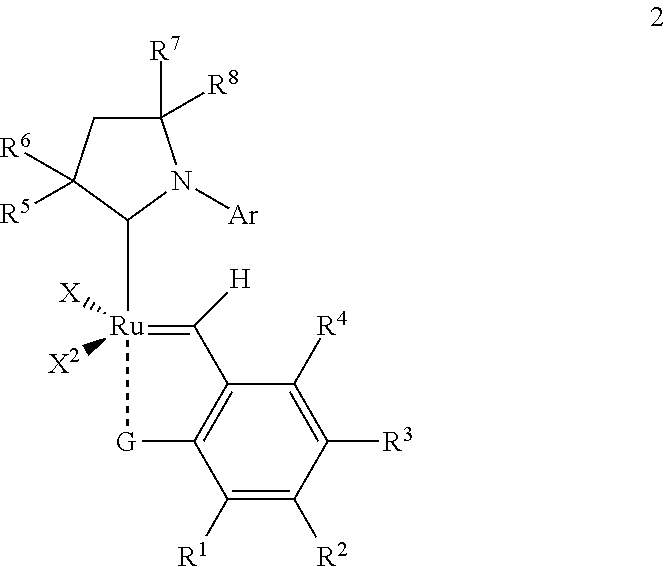
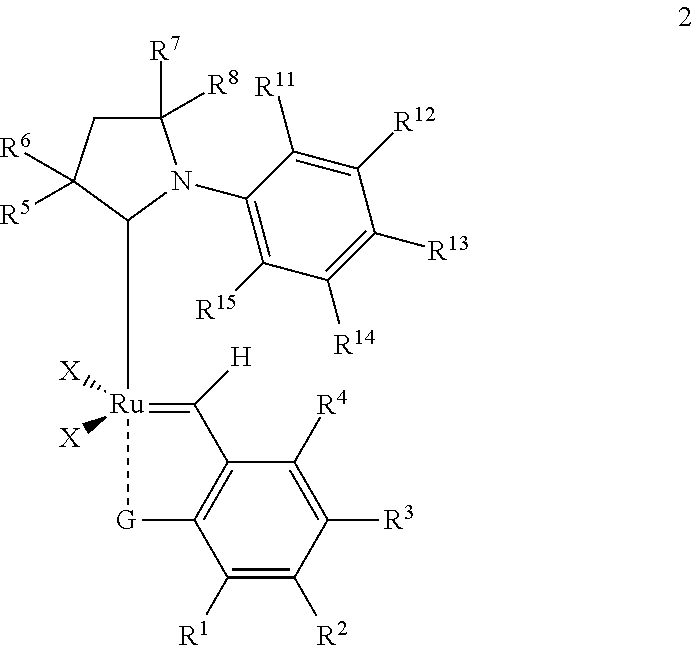
View All Diagrams
| United States Patent Application | 20190291089 |
| Kind Code | A1 |
| SKOWERSKI; Krzysztof ; et al. | September 26, 2019 |
USE OF RUTHENIUM COMPLEXES IN OLEFIN METATHESIS REACTION
Abstract
The invention relates to the use of ruthenium complexes, which are homogeneous catalysts and/or precatalysts of the olefin metathesis reaction, which lead to the production of alkenes containing an internal (non-terminal) double C.dbd.C bond. ##STR00001##
| Inventors: | SKOWERSKI; Krzysztof; (Jablonowo Pomorskie, PL) ; GAWIN; Rafal; (Warszawa, PL) ; CHWALBA; Michal Pawel; (Polajewo, PL) | ||||||||||
| Applicant: |
|
||||||||||
|---|---|---|---|---|---|---|---|---|---|---|---|
| Assignee: | APEIRON SYNTHESIS S.A. Wroclaw PL |
||||||||||
| Family ID: | 62110452 | ||||||||||
| Appl. No.: | 16/348721 | ||||||||||
| Filed: | November 9, 2017 | ||||||||||
| PCT Filed: | November 9, 2017 | ||||||||||
| PCT NO: | PCT/IB2017/056992 | ||||||||||
| 371 Date: | May 9, 2019 |
| Current U.S. Class: | 1/1 |
| Current CPC Class: | C07C 253/30 20130101; C07C 6/04 20130101; B01J 31/2204 20130101; C07C 253/30 20130101; C07C 2531/22 20130101; B01J 2540/62 20130101; C07C 67/475 20130101; C07C 6/04 20130101; C07C 67/333 20130101; C07C 2601/10 20170501; B01J 2231/543 20130101; C07C 6/04 20130101; C07C 255/07 20130101; C07C 69/593 20130101; C07C 11/04 20130101; B01J 31/181 20130101; C07C 11/02 20130101; C07C 67/347 20130101; C07C 67/333 20130101; B01J 2531/821 20130101; B01J 31/2273 20130101; C07C 69/74 20130101; C07F 15/0046 20130101; B01J 2540/40 20130101; C07C 67/475 20130101; C07C 253/30 20130101; B01J 31/2278 20130101; C07C 255/23 20130101; Y02P 20/52 20151101 |
| International Class: | B01J 31/22 20060101 B01J031/22; C07C 67/347 20060101 C07C067/347; C07C 253/30 20060101 C07C253/30; C07C 67/475 20060101 C07C067/475; C07F 15/00 20060101 C07F015/00 |
Foreign Application Data
| Date | Code | Application Number |
|---|---|---|
| Nov 10, 2016 | PL | PL419421 |
Claims
1. Use of a compound of formula 2, ##STR00044## wherein: X.sup.1 and X.sup.2 are each an anionic ligand; X.sup.1 and X.sup.2 may be interconnected to form a cyclic system; G is a halogen atom or a substituent selected from OR', SR', S(O)R', S(O).sub.2R' N(R')(R''), P(R')(R'')(R'''), where R', R'' and R''' are the same or different C.sub.1-C.sub.25 alkyl group, C.sub.3-C.sub.12 cycloalkyl group, C.sub.1-C.sub.25 alkoxy group, C.sub.2-C.sub.25 alkenyl group, C.sub.1-C.sub.12 perfluoroalkyl, C.sub.5-C.sub.20 aryl, C.sub.5-C.sub.24 aryloxy, C.sub.2-C.sub.20 heterocyclyl, C.sub.4-C.sub.20, heteroaryl, C.sub.5-C.sub.20, or which may involve the formation of a substituted or non-substituted cyclic C.sub.4-C.sub.10 or policyclic C.sub.4-C.sub.12 systems, which are optionally substituted with at least one C.sub.1-C.sub.12 alkyl, C.sub.1-C.sub.12 perfluoroalkyl, C.sub.1-C.sub.12 alkoxy, C.sub.5-C.sub.24 aryloxy, C.sub.2-C.sub.20 heterocyclyl, C.sub.4-C.sub.20 heteroaryl, C.sub.5-C.sub.20 heteroaryloxy, may also be substituted with an ester (--COOR'), amide (--CONR'.sub.2), formyl (--CHO), ketone (--COR'), hydroxamic (--CON(OR')(R')) groups, wherein R' is C.sub.1-C.sub.12 alkyl, C.sub.3-C.sub.12 cycloalkyl, C.sub.2-C.sub.12 alkenyl, C.sub.5-C.sub.20 aryl, which are optionally substituted with at least one C.sub.1-C.sub.12 alkyl, C.sub.1-C.sub.12 perfluoroalkyl, C.sub.1-C.sub.12 alkoxy, C.sub.5-C.sub.20 aryl, C.sub.5-C.sub.24 aryloxy, C.sub.7-C.sub.24 aralkyl, C.sub.2-C.sub.20 heterocycle, C.sub.4-C.sub.20, heteroaryl, C.sub.5-C.sub.20 heteroaryloxy, or a halogen atom; Ar is an aryl group that is substituted by hydrogen atoms, or optionally is substituted by at least one C.sub.1-C.sub.12 alkyl, C.sub.1-C.sub.12 perfluoroalkyl, C.sub.1-C.sub.12 alkoxy, C.sub.5-C.sub.24 aryloxy, C.sub.2-C.sub.20 heterocyclic, C.sub.4-C.sub.20 heteroaryl, C.sub.5-C.sub.20 heteroaryloxy, C.sub.7-C.sub.24 aralkyl, C.sub.5-C.sub.24 perfluoroaryl groups, or a halogen atom; R.sup.1, R.sup.2, R.sup.3, R.sup.4 are each a hydrogen atom, a (--S(O)R') sulphoxide group, a (--SO.sub.2NR'.sub.2) sulphonamide group, a (--P(O)(OR').sub.2) phosphonium group, a (--P(O)R'(OR')) phosphinium group, a (--P(OR').sub.2) phosphonous group, a (--PR'.sub.2) phosphine group, a (--NO.sub.2) nitro group, a (--NO) nitroso group, a (--COOH) carboxy group, a (--COOR') ester group, a (--CHO) formyl group, a (--COR') ketone group, a --NC(O)R' group, an amino group, an ammonium group, a (--OMe) alkoxy group, in which groups R' is C.sub.1-C.sub.5 alkyl, C.sub.1-C.sub.5 perfluoroalkyl, C.sub.5-C.sub.24 aryl, C.sub.7-C.sub.24 aralkyl, C.sub.5-C.sub.24 perfluoroaryl, C.sub.4-C.sub.20 heteroaryl, C.sub.5-C.sub.20 heteroaryloxy, and wherein R.sup.1, R.sup.2, R.sup.3 and R.sup.4 may be interconnected to form a cyclic system; R.sup.5, R.sup.6, R.sup.7 and R.sup.8 are each a hydrogen atom or a C.sub.1-C.sub.25, alkyl, C.sub.3-C.sub.12 cycloalkyl, C.sub.1-C.sub.5 perfluoroalkyl, C.sub.2-C.sub.12 alkenyl, C.sub.5-C.sub.20, aryl C.sub.5-C.sub.24 aryloxy, C.sub.2-C.sub.20 heterocycle, C.sub.4-C.sub.20 heteroaryl, C.sub.5-C.sub.20 heteroaryloxy, C.sub.7-C.sub.24 aralkyl C.sub.5-C.sub.24, which are optionally substituted by at least one C.sub.1-C.sub.12 alkyl, C.sub.1-C.sub.12, perfluoroalkyl, C.sub.1-C.sub.12 alkoxy, C.sub.5-C.sub.24 aryloxy, C.sub.4-C.sub.20 heteroaryl, C.sub.5-C.sub.20 heteroaryloxy or a halogen atom; and wherein R.sup.5 and R.sup.6 and/or R.sup.7 and R.sup.8 may be interconnected to form a cyclic system; in olefin metathesis reactions where at least one compound is formed as the main product containing at least one non-terminal double C.dbd.C bond, involving the process of contacting at least one type of olefin in the presence of a compound of formula 2, and wherein the compound of formula 2 is used in an amount of less than 0.1 mol %.
2. The use according to claim 1, wherein in formula 2 ##STR00045## X.sup.1 and X.sup.2 are halogen atoms, G is a halogen atom or a substituent selected from the OR', N(R')(R'') group, wherein R' and R'' are the same or different C.sub.1-C.sub.12 alkyl, C.sub.3-C.sub.12 cycloalkyl, C.sub.2-C.sub.12 alkenyl, C.sub.5-C.sub.20 aryl, which are optionally substituted by at least one C.sub.1-C.sub.12 alkyl, C.sub.1-C.sub.12 perfluoroalkyl, C.sub.1-C.sub.12 alkoxy, C.sub.5-C.sub.24 aryloxy, C.sub.5-C.sub.20 heteroaryloxy. R.sup.1, R.sup.2, R.sup.3, R.sup.4 are each a hydrogen atom, a (--S(O)R') sulphoxide group, a (--SO.sub.2NR'.sub.2) sulphonamide group, a (--P(O)(OR').sub.2) phosphonium group, a (--P(O)R'(OR')) phosphinium group, a (--P(OR').sub.2) phosphonous group, a (--PR'.sub.2) phosphine group, a (--NO.sub.2) nitro group, a (--NO) nitroso group, a (--COOH) carboxy group, a (--COOR') ester group, a (--CHO) formyl group, a (--COR') ketone group, a --NC(O)R' group, an amino group, an ammonium group, a (--OMe) alkoxy group, in which groups R' is C.sub.1-C.sub.5 alkyl, C.sub.1-C.sub.5 perfluoroalkyl, C.sub.5-C.sub.24 aryl, C.sub.7-C.sub.24 aralkyl, C.sub.5-C.sub.24 perfluoroaryl; R.sup.5, R.sup.6, R.sup.7 and R.sup.8 are each a hydrogen atom or an C.sub.1-C.sub.25 alkyl, a C.sub.3-C.sub.12 cycloalkyl, a C.sub.2-C.sub.12 alkenyl, a C.sub.5-C.sub.20 aryl, a C.sub.1-C.sub.5 perfluoroalkyl, a C.sub.7-C.sub.24 aralkyl, a C.sub.5-C.sub.24 perfluoroaryl groups, which are optionally substituted by at least one C.sub.1-C.sub.12 alkyl, C.sub.1-C.sub.12 perfluoroalkyl, C.sub.1-C.sub.12 alkoxy, C.sub.5-C.sub.24 aryloxy, C.sub.5-C.sub.20 heteroaryloxy, or a halogen atom; and wherein R.sup.5 and R.sup.6 and/or R.sup.7 and R.sup.8 may be interconnected to form a cyclic system
3. The use according to claim 1 or 2, wherein in formula 2 ##STR00046## X.sup.1 and X.sup.2 are halogen atoms, G is a halogen atom or a substituent selected from OR', N(R')(R''), wherein R' and R'' are the same or different C.sub.1-C.sub.12 alkyl, C.sub.3-C.sub.12 cycloalkyl, C.sub.5-C.sub.20 aryl, which are optionally substituted by at least one C.sub.1-C.sub.12 alkyl, C.sub.1-C.sub.12perfluoroalkyl, C.sub.1-C.sub.12 alkoxy, C.sub.5-C.sub.24 aryloxy, C.sub.5-C.sub.20 heteroaryloxy; R.sup.1, R.sup.2, R.sup.3, R.sup.4 are each a hydrogen atom, a (--S(O)R') sulphoxide group, a (--SO.sub.2NR'.sub.2) sulphonamide group, a (--NO.sub.2) nitro group, a (--COOR') ester group, a (--COR') ketone group, a --NC(O)R' group, an amino group, an ammonium group, a (--OMe) alkoxy group, in which groups R' is C.sub.1-C.sub.5 alkyl, C.sub.1-C.sub.5 perfluoroalkyl, C.sub.5-C.sub.24 aryl, C.sub.7-C.sub.24 aralkyl, C.sub.5-C.sub.24 perfluoroaryl; R.sup.5, R.sup.6, R.sup.7 and R.sup.8 are each a hydrogen atom or a C.sub.1-C.sub.25 alkyl, C.sub.3-C.sub.12 cycloalkyl, C.sub.5-C.sub.20 aryl, C.sub.7-C.sub.24aralkyl groups, which are optionally substituted by at least one C.sub.1-C.sub.12 alkyl, C.sub.1-C.sub.12 perfluoroalkyl, C.sub.1-C.sub.12 alkoxy, C.sub.5-C.sub.24 aryloxy, C.sub.5-C.sub.20 heteroaryloxy, or a halogen atom; and wherein R.sup.5 and R.sup.6 and/or R.sup.7 and R.sup.8 may be interconnected to form a cyclic system
4. The use according to any of the claims 1 to 3, wherein in formula 2 ##STR00047## X is an atom of chlorine or iodine G is a halogen atom or a substituent selected from OR', N(R')(R''), wherein R' and R'' are the same or different C.sub.1-C.sub.12 alkyl, C.sub.3-C.sub.12 cycloalkyl, C.sub.5-C.sub.20 aryl, which are optionally substituted by at least one C.sub.1-C.sub.12 alkyl, C.sub.1-C.sub.12perfluoroalkyl, C.sub.1-C.sub.12 alkoxy, C.sub.5-C.sub.24 aryloxy, C.sub.5-C.sub.20 heteroaryloxy; R.sup.1, R.sup.2, R.sup.3, R.sup.4 are each a hydrogen atom, a (--S(O)R') sulphoxide group, a (--SO.sub.2NR'.sub.2) sulphonamide group, a (--NO.sub.2) nitro group, a (--COOR') ester group, a (--COR') ketone group, a --NC(O)R' group, an amino group, an ammonium group, a (--OMe) alkoxy group, in which groups R' is C.sub.1-C.sub.5 alkyl, C.sub.1-C.sub.5 perfluoroalkyl, C.sub.5-C.sub.24 aryl, C.sub.7-C.sub.24 aralkyl, C.sub.5-C.sub.24 perfluoroaryl; R.sup.5, R.sup.6, R.sup.7 and R.sup.8 are each a hydrogen atom or a C.sub.1-C.sub.25 alkyl, C.sub.3-C.sub.12 cycloalkyl, C.sub.5-C.sub.20 aryl, C.sub.7-C.sub.24 aralkyl, which are optionally substituted by at least one C.sub.1-C.sub.12 alkyl C.sub.1-C.sub.12 perfluoroalkyl, C.sub.1-C.sub.12 alkoxy, C.sub.5-C.sub.24 aryloxy, C.sub.5-C.sub.20, heteroaryloxy, or a halogen atom; and wherein R.sup.5 and R.sup.6 and/or R.sup.7 and R.sup.8 may be interconnected to form a cyclic system; R.sup.11, R.sup.12, R.sup.13, R.sup.14 and R.sup.15 are each a hydrogen atom, a halogen atom, a C.sub.1-C.sub.25 alkyl group, a C.sub.3-C.sub.7, cycloalkyl group, a C.sub.1-C.sub.25 alkoxy group, a C.sub.5-C.sub.24 perfluoroaryl group, C.sub.5-C.sub.20 heteroaryl group or a C.sub.2-C.sub.25 alkenyl group, and wherein the substituents R.sup.2, R.sup.2', R.sup.3, R.sup.3' and R.sup.4 may be interconnected to form a substituted or non-substituted cyclic C.sub.4-C.sub.10 or policyclic C.sub.4-C.sub.12 system.
5. The use according to any of the claims 1 to 4, wherein in formula 2 ##STR00048## X is an atom of chlorine or iodine G is a halogen atom or a substituent selected from OR', N(R')(R''), wherein R' and R'' are the same or different C.sub.1-C.sub.12 alkyl, C.sub.3-C.sub.12 cycloalkyl, C.sub.5-C.sub.20 aryl, which are optionally substituted by at least one C.sub.1-C.sub.12 alkyl, C.sub.1-C.sub.12perfluoroalkyl, C.sub.1-C.sub.12 alkoxy, C.sub.5-C.sub.24 aryloxy, C.sub.5-C.sub.20 heteroaryloxy; R.sup.1, R.sup.2, R.sup.3, R.sup.4 are each a hydrogen atom, a (--S(O)R') sulphoxide group, a (--SO.sub.2NR'.sub.2) sulphonamide group, a (--NO.sub.2) nitro group, a (--COOR') ester group, a (--COR') ketone group, a --NC(O)R' group, an amino group, an ammonium group, a (--OMe) alkoxy group, in which groups R' is C.sub.1-C.sub.5 alkyl, C.sub.1-C.sub.5 perfluoroalkyl, C.sub.5-C.sub.24 aryl, C.sub.7-C.sub.24 aralkyl, C.sub.5-C.sub.24 perfluoroaryl; R.sup.5, R.sup.6, R.sup.7 and R.sup.8 are each a hydrogen atom or a C.sub.1-C.sub.25 alkyl, C.sub.3-C.sub.12 cycloalkyl, C.sub.5-C.sub.20 aryl, C.sub.7-C.sub.24aralkyl groups, which are optionally substituted by at least one C.sub.1-C.sub.12 alkyl, C.sub.1-C.sub.12 perfluoroalkyl, C.sub.1-C.sub.12 alkoxy, C.sub.5-C.sub.24 aryloxy, C.sub.5-C.sub.20 heteroaryloxy, or a halogen atom; and wherein R.sup.5 and R.sup.6 and/or R.sup.7 and R.sup.8 may be interconnected to form a cyclic system R.sup.11 and R.sup.15 are each methyl, ethyl or isopropyl R.sup.12, R.sup.13, R.sup.14 are each a hydrogen atom, a C.sub.1-C.sub.25 alkyl group,
6. The use according to any of the claims 1 to 5, wherein in formula 2 ##STR00049## X is an atom of chlorine or iodine G is a halogen atom or a substituent selected from OR', N(R')(R''), wherein R' is C.sub.1-C.sub.12 alkyl, C.sub.3-C.sub.12 cycloalkyl, C.sub.5-C.sub.20 aryl, which are optionally substituted by at least one C.sub.1-C.sub.12 alkyl, C.sub.1-C.sub.12 perfluoroalkyl, C.sub.1-C.sub.12 alkoxy, C.sub.5-C.sub.24 aryloxy, C.sub.5-C.sub.20 heteroaryloxy; R.sup.1, R.sup.2, R.sup.3, R.sup.4 are each a hydrogen atom, a (--S(O)R') sulphoxide group, a (--SO.sub.2NR'.sub.2) sulphonamide group, a (--NO.sub.2) nitro group, a (--COOR') ester group, a (--COR') ketone group, a --NC(O)R' group, an ammonium group, a (--OMe) alkoxy group, in which groups R' is C.sub.1-C.sub.5 alkyl, C.sub.1-C.sub.5 perfluoroalkyl, C.sub.5-C.sub.24 aryl, C.sub.7-C.sub.24 aralkyl, C.sub.5-C.sub.24 perfluoroaryl; R.sup.5, R.sup.6, R.sup.7 and R.sup.8 are each a hydrogen atom or a C.sub.1-C.sub.25 alkyl, C.sub.5-C.sub.20 aryl groups, which are optionally substituted by at least one C.sub.1-C.sub.12 alkyl, C.sub.1-C.sub.12 perfluoroalkyl, C.sub.1-C.sub.12 alkoxy, C.sub.5-C.sub.24 aryloxy, C.sub.5-C.sub.20 heteroaryloxy, or a halogen atom; and wherein R.sup.5 and R.sup.6 and/or R.sup.7 and R.sup.8 may be interconnected to form a cyclic system R.sup.11 and R.sup.15 are each methyl or ethyl; R.sup.12, R.sup.13, R.sup.14 are each a hydrogen atom, a C.sub.1-C.sub.25 alkyl group.
7. The use according to any of the claims 1 to 6, wherein the intercontacted olefins contain at least one nitrile moiety.
8. The use according to any of the claims 1 to 7, wherein one of the intercontacted olefins is acrylonitrile.
9. The use according to claim 7 or claim 8, wherein an olefin containing at least one nitrile moiety is used in the cross-metathesis (CM) reaction.
10. The use according to claim 8, wherein the acrylonitrile is used in an amount of from 1 to 6 equivalents of the second olefin.
11. The use according to claim 8, wherein the acrylonitrile is used in an amount of from 1.05 to 2 equivalents of the second olefin.
12. The use according to any of the preceding claims, wherein the reaction is conducted in an organic solvent such as toluene, benzene, mesitylene, dichloromethane, ethyl acetate, methyl acetate, tertbutyl methyl ether, cyclopentylmethyl ether, or with no solvent.
13. The use according to any of the preceding claims, wherein the reaction is conducted at a temperature of from 20 to 150.degree. C.
14. The use according to any of the preceding claims, wherein the reaction is conducted at a temperature of from 40 to 120.degree. C.
15. The use according to any of the preceding claims, wherein the reaction is conducted at a temperature of from 40 to 90.degree. C.
16. The use according to any of the preceding claims, wherein the reaction is conducted over from 5 minutes to 24 hours.
17. The use according to any of the preceding claims, wherein compound 2 is added to the reaction mixture in portions and/or continuously using a pump.
18. The use according to any of the preceding claims, wherein compound 2 is added to the reaction mixture as a solid and/or as a solution in an organic solvent.
19. The use according to any of the claims 8, 10 to 11, wherein acrylonitrile is added to the reaction mixture in portions and/or continuously using a pump.
20. The use according to any of the preceding claims, wherein the gaseous by-product of the reaction (ethylene, propylene, butylene) is actively removed from the reaction mixture using an inert gas or vacuum.
Description
[0001] The invention relates to the use of ruthenium complexes acting as catalysts and/or precatalysts in the olefin metathesis reaction.
[0002] A number of ruthenium complexes are known in the art that allow to obtain internal olefins [R. H. Grubbs (Ed.), AG Wenzel (Ed.), D. J. O'Leary (Ed.), E. Khosravi (Ed.), Handbook of Olefin Metathesis, 2nd edition, 3 Volumes, 2015, John Wiley & Sons, Inc. 1608 pages], among which one should note the 1st, 2nd and 3rd generations, and complexes comprising two, identical or different, N-heterocyclic carbene ligands (NHCs). In ruthenium complexes, the active, 14-electron catalyst form comprises a neutral ligand that is a phosphine or NHC [Grubbs et al. Chem. Rev. 2010, 110, 1746-1787; Nolan et al. Chem. Commun. 2014, 50, 10355-10375].
##STR00002## ##STR00003##
[0003] The most versatile and effective complexes are those of the 2nd generation--the so-called Grubbs catalysts (Gru-II), Hoveydy-Grubbs (Hov-II) and Indenylidene (Indium II), i.e. those that contain one NHC type ligand in their structure.
[0004] Cross-metathesis (CM) reaction with acrylonitrile (and its derivatives) is one of the most demanding olefin metathesis processes, since acrylonitrile is considered to be the type 3 olefin in metathesis reactions [no homodimerisation--J. Am. Chem. Soc., 2003, 125, 11360-11370]. On the other hand, CM of acrylonitrile with unsaturated esters, amides or other nitriles leads to the formation of bifunctional molecules with a considerable added value. For example, products of the CM of acrylonitrile with medium chain length esters containing a C.dbd.C terminal bond or with unsaturated fatty acid esters may be used to obtain aminoesters--monomers for the production of polyamids [Bruneau, P. H. Dixneuf et al., ChemSusChem, 2012, 5, 1410-1414, DOI:10.1002/cssc.201200086]. The most effective catalysts in an industrially significant cross-metathesis reaction with acrylonitrile [S. J. Connon and S. Blechert, Chem. Int. Ed. 2003, 42, 1900-1923, DOI:10.1002/anie.200200556], are Hov-II catalysts; even these complexes, however, allow for obtaining the maximum turn over number w (TON) of as little as 13,000 [Monatsh. Chem., 2015, 146, 1107-1113, DOI: 10.1007/s00706-015-1480-1] which prevents this methodology from being industrially used. Steric or electron modifications of Hov-II complexes did not produce a powerful improvement in CM with acrylonitrile. The inability to significantly improve the efficiency of complexes of ruthenium with NHC (expressed as TON) in reactions leading to the formation of internal C.dbd.C bonds is a substantial problem in the art.
[0005] According to the state of the art, ruthenium complexes containing a cyclic alkyl amino carbene ligand (CAAC) are used for obtaining terminal olefins in the way of cross-metathesis reaction with ethylene. At the stage of early work, Grubbs and Bertrand used standard ring closing metathesis (RCM) to evaluate the activity of the obtained CAAC ruthenium complexes [Angew. Chem., Int. Ed., 2007, 46, 7262-7265], using high volumes (1-5 mol %) of the catalyst. In the latest reports, the same authors determine the reactivity of the new ruthenium complexes containing the CAAC ligand by measuring the rate of their reaction with vinyl ether and do not attempt to synthesize the internal C.dbd.C bonds [US20140309433A1, Angew. Chem. Int. Ed., 2015, 54, 1919-1923]. Other authors attempted to modify the CAAC ligand framework by introducing a sterically crowded isopropyl substituent into the main ring [Zhang, Shi et al, Chem. Commun., 2013, 49, 9491-9493, DOI:10.1039/C3CC45823G]. Authors of this report used a high ruthenium complex load in the RCM reaction.
##STR00004## ##STR00005##
[0006] It is also known that CAAC ligand-containing ruthenium complexes show a significantly greater degree of non-productive metathesis compared to most NHC-containing complexes [J. Am. Chem. Soc. 2010, 132, 8534-8535, DOI:10.1021/ja1029045]. This is an undesirable characteristic in the synthesis of internal C.dbd.C bonds. Considering the current state of the art, it is therefore non-obvious to use the CAAC ruthenium complexes to obtain (in an economically advantageous manner) compounds containing an internal C.dbd.C bond.
[0007] In 2003, S. Blechert and others observed an advantageous effect of adding copper salt (I) on CM reactions catalyzed by Gru-II complexes with acrylonitrile [Eur. J. Org. Chem. 2003, 2225-2228, DOI:10.1002/ejoc.200300215]. The authors attributed the advantageous effect of the addition of copper salt (I) on the result of the CM reaction to the effect of scavenging phosphine from the reaction mixture and binding it into an insoluble complex.
[0008] In 2011, P. Dixneuf and Ch. Bruneau [Green Chem., 2011, 13, 2258-2271, DOI:10.1039/C1GC153770] have attempted to utilise products of ethenolysis of vegetable oils in acrylonitrile reactions producing raw materials that contained nitrogen. Other attempts to utilise vegetable oil metathesis products have been described by the same authors in their next paper [Green Chem., 2011, 13, 2911-2919, DOI: 10.1039/C1GC15569E], in which they subjected vegetable oil derivatives to various CM reactions with acrylonitrile and acrolein.
[0009] Yet another approach to obtaining compounds having two nitrile moieties in the molecule has been presented by Ch. Bruneau et al. [Monatsh. Chem., 2015, 146, 1107-1113, DOI:10.1007/s00706-015-1480-1] CM reactions were carried out with acrylonitrile and 10-undecenonitrile in the presence of commercially available ruthenium complexes. Hitherto, for demanding CM reactions with acrylonitrile, no ruthenium complexes have been identified that would allow using that process on an industrial scale, with high yields and favorable selectivities.
[0010] Authors of papers and authors of the inventions cited above emphasise the positive effect of reduced substrate concentration (high dilution of C<0.1 M was used) on the reaction yield.
[0011] To sum up the state of the art, a substantial problem is posed by low efficiency (expressed as the TON value) in reactions that lead to the formation of internal C.dbd.C bonds. A particular case of a demanding reaction with high industrial potential is the CM with acrylonitrile, for which there are currently no alternative tools (in the form of more efficient homogeneous ruthenium catalysts) that would allow for improving the yield while maintaining a high selectivity of the process.
[0012] It has been observed that in the presence of selected CAAC-ruthenium complexes the CM reactions with acrylonitrile are characterised by a very high TON even at a concentration of 1 M, which can result in a significant reduction in process costs.
[0013] Surprisingly, it has been observed that CAAC ruthenium complexes promote the formation of internal C.dbd.C bonds with the catalyst loading of 0.1 mol %, and in some cases at <0.002 mol %.
[0014] Furthermore, it has been surprisingly found that the CAAC ligand structure has a key effect on the efficiency and selectivity of CM reactions with vinyl derivatives containing electron deficient partners (EDP), such as methyl acrylate or acrylonitrile.
[0015] It has been shown that ruthenium complexes containing CAAC ligands with the general formula 1, 1a show higher efficiency in forming internal C.dbd.C internal bonds than the complexes containing NHC ligand of formula 1b. In addition, the complexes containing ligand 1 have been shown to be much more effective and selective in CM reactions with acrylonitrile than analogs containing CAAC ligands with the general formula 1a and than NHC-containing complexes of formula 1b.
##STR00006##
[0016] It has also been observed that substituents in the Ar.sup.1 group greatly affect the efficiency and selectivity in CM reactions with EDP. Grubbs and Bertrand describe the superior efficiency of the 2aa and 2ab complexes in the ethenolysis reaction of methyl oleate leading to the formation of two terminal olefins.
##STR00007##
[0017] Surprisingly, in the CM reactions with EDP, the 2aa complex was significantly less efficient and selective than the complexes containing the Ar.sup.1 moiety substituted in ortho positions with small or medium alkyl groups (Me, Et), such as the 2bc and 2bd complexes. Nevertheless, the phenyl substituent at the quaternary carbon atom made the 2aa complex more efficient and selective than the 2ab complex.
##STR00008##
[0018] NHC ruthenium complexes containing at the nitrogen atoms of the NHC ligand a phenyl ring substituted in the ortho position with isopropyl groups (the so-called SIPr ligand) show very good activity and efficiency in the formation of internal C.dbd.C bonds. Similarly, benzylidene ruthenium CAAC complexes in which the nitrogen atom is substituted with 2,6-diisopropylphenyl show good and very good efficiency in the ethenolysis reaction. Surprisingly, a very low activity and efficiency of the CAAC complexes containing isopropyl groups in the ortho position of the Ar.sup.1 have been observed in the reactions of the formation of internal C.dbd.C bonds. This activity is slightly increased at increased temperatures. For benzylidene CAAC complexes, a change in the activity is observed upon introduction of respective functional groups into the benzylidene ligand ring, known from benzylidene NHC complexes, is observed [for example: Angew. Chem. Int. Ed., 2002, 41 (21), 4038-4040].
[0019] Another advantage of the ruthenium complexes of the invention is the superior selectivity in the reaction of acrylonitrile and an internal olefin. In a reaction of an asymmetrical internal olefin (e.g. of methyl oleate (MO) with acrylonitrile, the formation of two CM products with acrylonitrile, two CM products with ethylene and two MO homometathesis products is observed. The MO homomethasis products are the least desirable by-product, as they have less industrial applications than the terminal olefins, and their re-introduction to the process is unfavourable due to the reduced reactivity of internal olefins having a substantial ratio of the trans isomer. The complexes of the invention in the reaction of MO with acrylonitrile lead to the formation of homometathesis products in a quantity that is several fold lower.
DISCLOSURE OF THE ESSENCE OF THE INVENTION
[0020] The application, therefore, relates to the use of a compound of formula 2,
##STR00009##
wherein: X.sup.1 and X.sup.2 are each an anionic ligand; G is a halogen atom or a substituent selected from OR', SR', S(O)R', S(O).sub.2R' N(R')(R''), P(R')(R'')(R'''), where R', R'' and R''' are the same or different C.sub.1-C.sub.25 alkyl group, C.sub.3-C.sub.12 cycloalkyl group, C.sub.1-C.sub.25 alkoxy group, C.sub.2-C.sub.25 alkenyl group, C.sub.1-C.sub.12 perfluoroalkyl, C.sub.5-C.sub.20 aryl, C.sub.5-C.sub.24 aryloxy, C.sub.2-C.sub.20 heterocyclyl, C.sub.4-C.sub.20, heteroaryl, C.sub.5-C.sub.20, or which may involve the formation of a substituted or non-substituted cyclic C.sub.4-C.sub.10 or policyclic C.sub.4-C.sub.12 systems, which are optionally substituted with at least one C.sub.1-C.sub.12 alkyl, C.sub.1-C.sub.12 perfluoroalkyl, C.sub.1-C.sub.12 alkoxy, C.sub.5-C.sub.24 aryloxy, C.sub.2-C.sub.20 heterocyclyl, C.sub.4-C.sub.20 heteroaryl, C.sub.5-C.sub.20 heteroaryloxy, may also be substituted with an ester (--COOR'), amide (--CONR'.sub.2), formyl (--CHO), ketone (--COR'), hydroxamic (--CON(OR')(R')) groups, wherein R' is C.sub.1-C.sub.12 alkyl, C.sub.3-C.sub.12 cycloalkyl, C.sub.2-C.sub.12 alkenyl, C.sub.5-C.sub.20 aryl, which are optionally substituted with at least one C.sub.1-C.sub.12 alkyl, C.sub.1-C.sub.12 perfluoroalkyl, C.sub.1-C.sub.12 alkoxy, C.sub.5-C.sub.20 aryl, C.sub.5-C.sub.24 aryloxy, C.sub.7-C.sub.24 aralkyl, C.sub.2-C.sub.20 heterocycle, C.sub.4-C.sub.20, heteroaryl, C.sub.5-C.sub.20 heteroaryloxy, or a halogen atom; Ar is an aryl group that is substituted by hydrogen atoms, or optionally is substituted by at least one C.sub.1-C.sub.12 alkyl, C.sub.1-C.sub.12 perfluoroalkyl, C.sub.1-C.sub.12 alkoxy, C.sub.5-C.sub.24 aryloxy, C.sub.2-C.sub.20 heterocyclic, C.sub.4-C.sub.20 heteroaryl, C.sub.5-C.sub.20 heteroaryloxy, C.sub.7-C.sub.24 aralkyl, C.sub.5-C.sub.24 perfluoroaryl groups, or a halogen atom; R.sup.1, R.sup.2, R.sup.3, R.sup.4 are each a hydrogen atom, a (--S(O)R') sulphoxide group, a (--SO.sub.2NR'.sub.2) sulphonamide group, a (--P(O)(OR').sub.2) phosphonium group, a (--P(O)R'(OR')) phosphinium group, a (--P(OR').sub.2) phosphonous group, a (--PR'.sub.2) phosphine group, a (--NO.sub.2) nitro group, a (--NO) nitroso group, a (--COOH) carboxy group, a (--COOR') ester group, a (--CHO) formyl group, a (--COR') ketone group, a --NC(O)R' group, an amino group, an ammonium group, a (--OMe) alkoxy group, in which groups R' is C.sub.1-C.sub.5 alkyl, C.sub.1-C.sub.5 perfluoroalkyl, C.sub.5-C.sub.24 aryl, C.sub.7-C.sub.24 aralkyl, C.sub.5-C.sub.24 perfluoroaryl, C.sub.4-C.sub.20 heteroaryl, C.sub.5-C.sub.20 heteroaryloxy, and wherein R.sup.1, R.sup.2, R.sup.3 and R.sup.4 may be interconnected to form a cyclic system; R.sup.5, R.sup.6, R.sup.7 and R.sup.8 are each a hydrogen atom or a C.sub.1-C.sub.25, alkyl, C.sub.3-C.sub.12 cycloalkyl, C.sub.1-C.sub.5 perfluoroalkyl, C.sub.2-C.sub.12 alkenyl, C.sub.5-C.sub.20, aryl C.sub.5-C.sub.24 aryloxy, C.sub.2-C.sub.20 heterocycle, C.sub.4-C.sub.20 heteroaryl, C.sub.5-C.sub.20 heteroaryloxy, C.sub.7-C.sub.24 aralkyl C.sub.5-C.sub.24, which are optionally substituted by at least one C.sub.1-C.sub.12 alkyl, C.sub.1-C.sub.12, perfluoroalkyl, C.sub.1-C.sub.12 alkoxy, C.sub.5-C.sub.24 aryloxy, C.sub.4-C.sub.20 heteroaryl, C.sub.5-C.sub.20 heteroaryloxy or a halogen atom; and wherein R.sup.5 and R.sup.6 and/or R.sup.7 and R.sup.8 may be interconnected to form a cyclic system; in olefin metathesis reactions where at least one compound is formed as the main product containing at least one non-terminal double C.dbd.C bond, involving the process of contacting at least one type of olefin in the presence of a compound of formula 2.
[0021] Preferably, said compound is represented by formula 2
##STR00010##
wherein: X.sup.1 and X.sup.2 are halogen atoms, G is a halogen atom or a substituent selected from the OR', N(R')(R'') group, wherein R' and R'' are the same or different C.sub.1-C.sub.12 alkyl, C.sub.3-C.sub.12 cycloalkyl, C.sub.2-C.sub.12 alkenyl, C.sub.5-C.sub.20 aryl, which are optionally substituted by at least one C.sub.1-C.sub.12 alkyl, C.sub.1-C.sub.12 perfluoroalkyl, C.sub.1-C.sub.12 alkoxy, C.sub.5-C.sub.24 aryloxy, C.sub.5-C.sub.20 heteroaryloxy; R.sup.1, R.sup.2, R.sup.3, R.sup.4 are each a hydrogen atom, a (--S(O)R') sulphoxide group, a (--SO.sub.2NR'.sub.2) sulphonamide group, a (--P(O)(OR').sub.2) phosphonium group, a (--P(O)R'(OR')) phosphinium group, a (--P(OR').sub.2) phosphonous group, a (--PR'.sub.2) phosphine group, a (--NO.sub.2) nitro group, a (--NO) nitroso group, a (--COOH) carboxy group, a (--COOR') ester group, a (--CHO) formyl group, a (--COR') ketone group, a --NC(O)R' group, an amino group, an ammonium group, a (--OMe) alkoxy group, in which groups R' is C.sub.1-C.sub.5 alkyl, C.sub.1-C.sub.5 perfluoroalkyl, C.sub.5-C.sub.24 aryl, C.sub.7-C.sub.24 aralkyl, C.sub.5-C.sub.24 perfluoroaryl; R.sup.5, R.sup.6, R.sup.7 and R.sup.8 are each a hydrogen atom or an C.sub.1-C.sub.25 alkyl, a C.sub.3-C.sub.12 cycloalkyl, a C.sub.2-C.sub.12 alkenyl, a C.sub.5-C.sub.20 aryl, a C.sub.1-C.sub.5 perfluoroalkyl, a C.sub.7-C.sub.24 aralkyl, a C.sub.5-C.sub.24 perfluoroaryl groups, which are optionally substituted by at least one C.sub.1-C.sub.12 alkyl, C.sub.1-C.sub.12 perfluoroalkyl, C.sub.1-C.sub.12 alkoxy, C.sub.5-C.sub.24 aryloxy, C.sub.5-C.sub.20 heteroaryloxy, or a halogen atom; and wherein R.sup.5 and R.sup.6 and/or R.sup.7 and R.sup.8 may be interconnected to form a cyclic system
[0022] Preferably, said compound is represented by formula 2
##STR00011##
wherein: X.sup.1 and X.sup.2 are halogen atoms, G is a halogen atom or a substituent selected from the OR', N(R')(R'') group, wherein R' is C.sub.1-C.sub.12 alkyl, C.sub.3-C.sub.12 cycloalkyl, C.sub.5-C.sub.20 aryl, which are optionally substituted by at least one C.sub.1-C.sub.12 alkyl, C.sub.1-C.sub.12 perfluoroalkyl, C.sub.1-C.sub.12 alkoxy, C.sub.5-C.sub.24 aryloxy, C.sub.5-C.sub.20 heteroaryloxy; R.sup.1, R.sup.2, R.sup.3, R.sup.4 are each a hydrogen atom, a (--S(O)R') sulphoxide group, a (--SO.sub.2NR'.sub.2) sulphonamide group, a (--NO.sub.2) nitro group, a (--COOR') ester group, a (--COR') ketone group, a --NC(O)R' group, an amino group, an ammonium group, a (--OMe) alkoxy group, in which groups R' is C.sub.1-C.sub.5 alkyl, C.sub.1-C.sub.5 perfluoroalkyl, C.sub.5-C.sub.24 aryl, C.sub.7-C.sub.24 aralkyl, C.sub.5-C.sub.24 perfluoroaryl; R.sup.5, R.sup.6, R.sup.7 and R.sup.8 are each a hydrogen atom or an C.sub.1-C.sub.25 alkyl, a C.sub.3-C.sub.12 cycloalkyl, a C.sub.5-C.sub.20 aryl, a C.sub.7-C.sub.24 aralkyl, which are optionally substituted by at least one C.sub.1-C.sub.12 alkyl, C.sub.1-C.sub.12 perfluoroalkyl, C.sub.1-C.sub.12 alkoxy, C.sub.5-C.sub.24 aryloxy, C.sub.5-C.sub.20 heteroaryloxy, or a halogen atom; and wherein R.sup.5 and R.sup.6 and/or R.sup.7 and R.sup.8 may be interconnected to form a cyclic system
[0023] Preferably, said compound is represented by formula 2
##STR00012##
wherein: X is an atom of chlorine or iodine G is a halogen atom or a substituent selected from a OR', N(R')(R'') group, wherein R' is C.sub.1-C.sub.12 alkyl, C.sub.3-C.sub.12 cycloalkyl, C.sub.5-C.sub.20 aryl, which are optionally substituted by at least one C.sub.1-C.sub.12 alkyl, C.sub.1-C.sub.12perfluoroalkyl, C.sub.1-C.sub.12 alkoxy, C.sub.5-C.sub.24, aryloxy, C.sub.5-C.sub.20 heteroaryloxy; R.sup.1, R.sup.2, R.sup.3, R.sup.4 are each a hydrogen atom, a (--S(O)R') sulphoxide group, a (--SO.sub.2NR'.sub.2) sulphonamide group, a (--NO.sub.2) nitro group, a (--COOR') ester group, a (--COR') ketone group, a --NC(O)R' group, an amino group, an ammonium group, a (--OR) alkoxy group, in which groups R' is C.sub.1-C.sub.5 alkyl, C.sub.1-C.sub.5 perfluoroalkyl, C.sub.5-C.sub.24 aryl, C.sub.7-C.sub.24 aralkyl, C.sub.5-C.sub.24 perfluoroaryl; R.sup.5, R.sup.6, R.sup.7 and R.sup.8 are each a hydrogen atom or a C.sub.1-C.sub.25 alkyl, C.sub.3-C.sub.12 cycloalkyl, C.sub.5-C.sub.20 aryl, C.sub.7-C.sub.24 aralkyl, which are optionally substituted by at least one C.sub.1-C.sub.12 alkyl C.sub.1-C.sub.12 perfluoroalkyl, C.sub.1-C.sub.12 alkoxy, C.sub.5-C.sub.24 aryloxy, C.sub.5-C.sub.20, heteroaryloxy, or a halogen atom; and wherein R.sup.5 and R.sup.6 and/or R.sup.7 and R.sup.8 may be interconnected to form a cyclic system; R.sup.11, R.sup.12, R.sup.13, R.sup.14 and R.sup.15 are each a hydrogen atom, a halogen atom, a C.sub.1-C.sub.25 alkyl group, a C.sub.3-C.sub.7, cycloalkyl group, a C.sub.1-C.sub.25 alkoxy group, a C.sub.5-C.sub.24 perfluoroaryl group, C.sub.5-C.sub.20 heteroaryl group or a C.sub.2-C.sub.25 alkenyl group, and wherein the substituents R.sup.2, R.sup.2', R.sup.3, R.sup.3' and R.sup.4 may be interconnected to form a substituted or non-substituted cyclic C.sub.4-C.sub.10 or policyclic C.sub.4-C.sub.12 system.
[0024] Preferably, said compound is represented by formula 2
##STR00013##
wherein: X is an atom of chlorine or iodine G is a halogen atom or a substituent selected from OR', N(R')(R''), wherein R' is C.sub.1-C.sub.12 alkyl, C.sub.3-C.sub.12 cycloalkyl, C.sub.5-C.sub.20 aryl, which are optionally substituted by at least one C.sub.1-C.sub.12 alkyl, C.sub.1-C.sub.12 perfluoroalkyl, C.sub.1-C.sub.12 alkoxy, C.sub.5-C.sub.24 aryloxy, C.sub.5-C.sub.20 heteroaryloxy; R.sup.1, R.sup.2, R.sup.3, R.sup.4 are each a hydrogen atom, a (--S(O)R') sulphoxide group, a (--SO.sub.2NR'.sub.2) sulphonamide group, a (--NO.sub.2) nitro group, a (--COOR') ester group, a (--COR') ketone group, a --NC(O)R' group, an amino group, an ammonium group, a (--OMe) alkoxy group, in which groups R' is C.sub.1-C.sub.5 alkyl, C.sub.1-C.sub.5 perfluoroalkyl, C.sub.5-C.sub.24 aryl, C.sub.7-C.sub.24 aralkyl, C.sub.5-C.sub.24 perfluoroaryl; R.sup.5, R.sup.6, R.sup.7 and R.sup.8 are each a hydrogen atom or a C.sub.1-C.sub.25 alkyl, C.sub.3-C.sub.12 cycloalkyl, C.sub.5-C.sub.20 aryl, C.sub.7-C.sub.24 aralkyl groups, which are optionally substituted by at least one C.sub.1-C.sub.12 alkyl, C.sub.1-C.sub.12 perfluoroalkyl, C.sub.1-C.sub.12 alkoxy, C.sub.5-C.sub.24 aryloxy, C.sub.5-C.sub.20 heteroaryloxy, or a halogen atom; and wherein R.sup.5 and R.sup.6 and/or R.sup.7 and R.sup.8 may be interconnected to form a cyclic system R.sup.11 and R.sup.15 are each methyl, ethyl or isopropyl R.sup.12, R.sup.13, R.sup.14 are each a hydrogen atom, a C.sub.1-C.sub.25 alkyl group,
[0025] Preferably, said compound is represented by formula 2
##STR00014##
wherein: X is an atom of chlorine or iodine G is a halogen atom or a substituent selected from OR', N(R')(R''), wherein R' is C.sub.1-C.sub.12 alkyl, C.sub.3-C.sub.12 cycloalkyl, C.sub.5-C.sub.20 aryl, which are optionally substituted by at least one C.sub.1-C.sub.12 alkyl, C.sub.1-C.sub.12 perfluoroalkyl, C.sub.1-C.sub.12 alkoxy, C.sub.5-C.sub.24 aryloxy, C.sub.5-C.sub.20 heteroaryloxy;
[0026] R.sup.1, R.sup.2, R.sup.3, R.sup.4 are each a hydrogen atom, a (--S(O)R') sulphoxide group, a (--SO.sub.2NR'.sub.2) sulphonamide group, a (--NO.sub.2) nitro group, a (--COOR') ester group, a (--COR') ketone group, a --NC(O)R' group, an ammonium group, a (--OMe) alkoxy group, in which groups R' is C.sub.1-C.sub.5 alkyl, C.sub.1-C.sub.5 perfluoroalkyl, C.sub.5-C.sub.24 aryl, C.sub.7-C.sub.24 aralkyl, C.sub.5-C.sub.24 perfluoroaryl;
[0027] R.sup.5, R.sup.6, R.sup.7 and R.sup.8 are each a hydrogen atom or a C.sub.1-C.sub.25 alkyl, C.sub.5-C.sub.20 aryl groups, which are optionally substituted by at least one C.sub.1-C.sub.12 alkyl, C.sub.1-C.sub.12 perfluoroalkyl, C.sub.1-C.sub.12 alkoxy, C.sub.5-C.sub.24 aryloxy, C.sub.5-C.sub.20 heteroaryloxy, or a halogen atom; and wherein R.sup.5 and R.sup.6 and/or R.sup.7 and R.sup.8 may be interconnected to form a cyclic system
R.sup.11 and R.sup.15 are each methyl or ethyl; R.sup.12, R.sup.13, R.sup.14 are each a hydrogen atom, a C.sub.1-C.sub.25 alkyl group.
[0028] Preferably, the intercontacted olefins contain at least one nitrile moiety.
[0029] Preferably, one of the intercontacted olefins is acrylonitrile.
[0030] Preferably, an olefin containing at least one nitrile moiety is used in the cross-metathesis (CM) reaction.
[0031] Preferably, acrylonitrile is used in an amount of from 1 to 6 equivalents of the second olefin.
[0032] Preferably, acrylonitrile is used in an amount of from 1.05 to 2 equivalents of the second olefin.
[0033] Preferably, the reaction is conducted in an organic solvent such as toluene, benzene, mesitylene, dichloromethane, ethyl acetate, methyl acetate, tertbutyl methyl ether, cyclopentylmethyl ether, or with no solvent.
[0034] Preferably, the reaction is conducted at a temperature of from 20 to 150.degree. C.
[0035] Preferably, the reaction is conducted at a temperature of from 40 to 120.degree. C.
[0036] Preferably, the reaction is conducted at a temperature of from 40 to 90.degree. C.
[0037] Preferably, the reaction is conducted over from 5 minutes to 24 hours.
[0038] Preferably, compound 2 is used in an amount of less than 0.1 mol %.
[0039] Preferably, compound 2 is added to the reaction mixture in portions and/or continuously using a pump.
[0040] Preferably, compound 2 is added to the reaction mixture as a solid and/or as a solution in an organic solvent.
[0041] Preferably, acrylonitrile is added to the reaction mixture in portions and/or continuously using a pump.
[0042] Preferably, the gaseous by-product of the reaction (ethylene, propylene, butylene) is actively removed from the reaction mixture using an inert gas or vacuum.
[0043] The invention will be presented in greater detail in preferred embodiments, with reference to the accompanying drawings, in which:
[0044] FIG. 1 shows the summary of olefin metathesis precatalysts and/or catalysts used according to the present invention.
TERMS
[0045] The terms used in the present description have the meanings as follows. Non-defined terms in this document have the meaning given and understood by a person skilled in the art in the light of the best knowledge held, of the present disclosure, and of the context of the description of the patent application. Unless it is indicated otherwise, the following conventional chemistry terms are used the present description that have the meanings as defined below.
[0046] The term "halogen atom" or "halogen" refers to an element selected from F, Cl, Br, I.
[0047] The term "carbene" refers to a particle containing a neutral carbon atom with a valence number of two and having two unpaired (triplet state) or paired (singlet state) valence electrons. The term "carbene" also includes carbene analogs in which the carbon atom is substituted by another chemical element such as boron, silicon, germanium, tin, lead, nitrogen, phosphorus, sulphur, selenium and tellurium.
[0048] The term "alkyl" refers to a saturated, linear or branched hydrocarbon substituent having the indicated number of carbon atoms. Examples of alkyl substituents include -methyl, -ethyl, -n-propyl, -n-butyl, -n-pentyl, -n-hexyl, -n-heptyl, -n-octyl, n-nonyl, and -n-decyl. Representative branched-(C.sub.1-C.sub.10)alkyls include -isopropyl, -sec-butyl, -isobutyl, -tert-butyl, -isopentyl, -neopentyl, -1-methylobutyl, -2-methylobutyl, -3-methylobutyl, -1,1-dimethylopropyl, -1,2-d imethylopropyl, -1-methylopentyl, -2-methylopentyl, -3-methylopentyl, -4-methylopentyl, -1-ethylobutyl, -2-ethylobutyl, -3-ethylobutyl, -1,1-dimethylobutyl, -1,2-dimethylobutyl, 1,3-dimethylobutyl, -2,2-dimethylobutyl, -2,3-dimethylobutyl, -3,3-dimethylobutyl, -1-methylohexyl, 2-methylohexyl, -3-methylohexyl, -4-methylohexyl, -5-methylohexyl, -1,2-dimethylopentyl, -1,3-dimethylopentyl, -1,2-dimethylohexyl, -1,3-dimethylohexyl, -3,3-dimethylohexyl, 1,2-dimethyloheptyl, -1,3-dimethyloheptyl, -3,3-dimethyloheptyl and the like.
[0049] The term "alkoxy" refers to an alkyl substituent as defined above bound by an oxygen atom.
[0050] The term "perfluoroalkyl" refers to an alkyl group as defined above in which all the hydrogen atoms have been substituted by the same or different halogen atoms.
[0051] The term "cycloalkyl" refers to a saturated mono- or polycyclic hydrocarbon substituent having the indicated number of carbon atoms. Examples of cycloalkyl substituents include -cyclopropyl, -cyclobutyl, -cyclopentyl, -cyclohexyl, -cycloheptyl, -cyclooctyl, -cyclononyl, -cyclodecyl and the like.
[0052] The term "alkenyl" refers to a saturated, linear or branched non-cyclic hydrocarbon substituent of the indicated number of carbon atoms and containing at least one double carbon-carbon bond. Examples of alkenyl substituents include -vinyl, -allyl, -1-butenyl, -2-butenyl, -isobutylenyl, -1-pentenyl, -2-pentenyl, -3-methylo-1-butenyl, -2-methylo-2-butenyl, -2,3-dimethylo-2-butenyl, -1-hexenyl, -2-hexenyl, -3-hexenyl, -1-heptenyl, -2-heptenyl, -3-heptenyl, -1-octenyl, -2-octenyl, -3-octenyl, -1-nonenyl, -2-nonenyl, -3-nonenyl, -1-decenyl, -2-decenyl, -3-decenyl and the like.
[0053] The term "cycloalkenyl" refers to a saturated mono- or polycyclic hydrocarbon substituent of the indicated number of carbon atoms and containing at least one double carbon-carbon bond. Examples of cycloalkenyl substituents include cyclopentenyl, cyclopentadienyl, cyclohexenyl, cyclohexadienyl, cycloheptenyl, cycloheptadienyl, cycloheptatrienyl, cyclooctenyl, cyclooctadienyl, cyclooctatrienyl, cyclooctatetraenyl, cyclononenyl, cyclopentadienyl, cyclodecenyl, cyclodecadienyl and the like.
[0054] The term "alkynyl" refers to a saturated, linear or branched non-cyclic hydrocarbon substituent of the indicated number of carbon atoms and containing at least one triple carbon-carbon bond. Examples of alkynyl substituents include acetylenyl, propynyl, -1-butynyl, -2-butynyl, -1-pentynyl, -2-pentynyl, -3-methyl-1-butynyl, 4-pentynyl, -1-hexynyl, 2-hexynyl, -5-hexynyl and the like.
[0055] The term "cycloalkynyl" refers to a saturated mono- or polycyclic hydrocarbon substituent of the indicated number of carbon atoms and containing at least one triple carbon-carbon bond. Examples of cycloalkynyl substituents include cyclohexnyl, -cycloheptynyl, -cyclooctynyl and the like.
[0056] The term "aryl" refers to an aromatic mono- or polycyclic hydrocarbon substituent having the indicated number of carbon atoms. Examples of aryl substituents include phenyl, -tolyl, -xylyl, -naphthyl, -2,4,6-trimethylphenyl, -2-fluorophenyl, -4-fluorophenyl, -2,4,6-trifluorophenyl, -2,6-difluorophenyl, -4-nitrophenyl and the like.
[0057] The term "aralkyl" refers to an alkyl substituent as defined above substituted with at least one aryl as defined above. Examples of aralkyl substituents include benzyl, -diphenylmethyl, -triphenylmethyl and the like.
[0058] The term "heteroaryl" refers to an aromatic mono- or polycyclic hydrocarbon substituent having the indicated number of carbon atoms, in which at least one carbon atom is substituted by a heteroatom selected from O, N and S atoms. Examples of heteroaryl substituents include furyl, thienyl, imidazolyl, oxazolyl, thiazolyl, isoxazolyl, triazolyl, oxadiazolyl, thiadiazolyl, tetrazolyl, pyridyl, pyrimidyl, triazinyl, indolyl, benzo[b]furyl, benzo[b]thienyl, indazolyl, benzoimidazolyl, azaindolyl, quinolyl, isoquinolyl, carbazolyl and the like.
[0059] The term "heterocycle" refers to a saturated or partially non-saturated, mono- or polycyclic hydrocarbon substituent having the indicated number of carbon atoms, in which at least one carbon atom is substituted by a heteroatom selected from O, N and S atoms. Examples of heterocyclic substituents include furyl, thiophenyl, pyrrolyl, oxazolyl, imidazolyl, thiazolyl, isoxazolyl, pyrazolyl, isothiazolyl, triazinyl, pyrrolidinonyl, pyrrolidinyl, hydantoinyl, oxiranyl, oxetanyl, tetrahydrofuranyl, tetrahydrothiophenyl, quinolinyl, isoquinolinyl, chromonyl, coumarinyl, indolyl, indolizinyl, benzo[b]furanyl, benzo[b]thiophenyl, indazolyl, purinyl, 4H-quinolizinyl, isoquinolyl, quinolyl, phthalazinyl, naphthyridinyl, carbazolyl, .beta.-carbolinyl and the like.
[0060] The term "neutral ligand" refers to a non-charged substituent capable of coordinating with a metallic centre (the ruthenium atom). Examples of such ligands may include: amines, phosphines and oxides thereof, alkyl and aryl phosphites and phosphates, arsines and oxides thereof, ethers, alkyl and aryl sulphides, coordinated hydrocarbons, alkyl and aryl halides.
[0061] The term "anionic ligand" refers to a substituent capable of coordinating with a metallic centre (the ruthenium atom) with a charge capable of partially or completely compensating the charge of the metallic centre. Examples of such ligands may include fluoride, chloride, bromide, iodide, cyanide, cyanate and thiocyanate anions, carboxylic acid anions, alcohol anions, phenolic anions, thiol and thiophenol anions, delocalized charge hydrocarbon anions (e.g. cyclopentadiene), (organo)sulphuric and (organo)phosphoric acid anions and esters thereof (such as, for example, alkylsulphonic and aryl sulphonic acid anions, alkylphosphoric and arylphosphoric acid anions, sulphuric acid alkyl and aryl ester anions, phosphoric acid alkyl and aryl ester anions, alkylphosphoric and arylphosphoric alkyl and aryl ester anions). Optionally, the anionic ligand may have interconnected L.sup.1, L.sup.2 and L.sup.3 groups, such as the catechol anion, the acetylacetone anion, the salicylaldehyde anion. Anionic ligands (X.sup.1, X.sup.2) and neutral ligands (L.sup.1, L.sup.2, L.sup.3) may be interconnected to form multidentate ligands, such as a bidentate ligand (X.sup.1--X.sup.2), a tridentate ligand (X.sup.1--X.sup.2-L.sup.1) a tetradentate ligand (X.sup.1--X.sup.2-L.sup.1-L.sup.2), a bidentate ligand (X.sup.1-L.sup.1), a tridentate ligand (X.sup.1-L.sup.1-L.sup.2), a tetradentate ligand (X.sup.1-L.sup.1-L.sup.2-L.sup.3), a bidentate ligand (L.sup.1-L.sup.2), a tridentate ligand (L.sup.1-L.sup.2-L.sup.3). Examples of such ligands include catechol anion, acetylacetone anion and salicylaldehyde anion.
[0062] The term "heteroatom" refers to an atom selected from the group comprising an atom of oxygen, sulphur, nitrogen, phosphorus and the like.
[0063] The term "chlorinated solvent" refers to a solvent, the structure of which comprises at least one atom of for example fluorine, chlorine, bromine and iodine; preferably more than one. Examples of such solvents include dichloromethane, chloroform, tetrachloromethane (carbon tetrachloride), 1,2-dichloroethane, chlorobenzene, perfluorobenzene, perfluorotoluene, freons and the like.
[0064] The term "organic non-polar solvent" refers to a solvent characterised by non-existent or very low dipole momentum. Examples of such solvents include pentane, hexane, octane, nonane, decane, benzene, toluene, xylene and the like.
[0065] The term "organic polar solvent" refers to a solvent characterised by a dipole momentum substantially greater than zero. Examples of such solvents include dimethylformamide (DMF), tetrahydrofuran (THF) and its derivatives, diethyl ether, dichloromethane, ethyl acetate, chloroform, alcohols (MeOH, EtOH or i-PrOH) and the like.
[0066] The term "GC" refers to gas chromatography.
[0067] The term "HPLC" refers to high performance liquid chromatography, and solvents designated as "HPLC" solvents refer to solvents having sufficient purity for HPLC analysis.
[0068] The term "NMR" refers to nuclear magnetic resonance.
[0069] The term "NHC" refers to N-heterocyclic carbene.
[0070] The term "CAAC" refers to cyclic alkyl amino carbene ligand.
[0071] The term "DEDAM" refers to diethyl diallylmalonate.
[0072] The term "precatalyst" refers to, in relation to ruthenium complexes, a 16-electron chemical compound which, after the step of dissociation of one ligand or reorganisation of the molecule, is converted to the 14-electron olefin metathesis catalyst as such, which is active in the catalytic cycle.
EMBODIMENTS OF THE INVENTION
[0073] The following examples are provided solely for the purpose of illustrating the invention and for clarifying the individual aspects thereof, and not with the intention to limit it, and should not be considered to be equivalent to the total scope thereof as defined in the appended claims. In the examples below, unless otherwise indicated, standard materials and methods were employed as used in the art or it was proceeded according to the manufacturer's recommendations for particular reagents and methods.
[0074] Ethyl undecanoate (EU), 1-decene, acrylonitrile, methyl acrylate, methyl oleate (MO) and methyl stearate are commercially available compounds. EU and MO were distilled under reduced pressure and stored over activated alumina. 1-decene, acrylonitrile and methyl acrylate were dried using 4 .ANG. molecular sieves and deoxygenated under argon. All reactions were conducted under argon. Toluene was washed with citric acid, water, dried using 4 .ANG. molecular sieves and deoxygenated under argon.
[0075] The composition of reaction mixtures was tested by gas chromatography using a PerkinElmer Clarus 680 GC equipped with the GL Sciences InertCap.RTM. 5MS/NP capillary column.
[0076] The individual components of reaction mixtures were identified by comparing retention times with commercial standards or standards isolated from reaction mixtures for which the structure was confirmed by NMR.
[0077] The FID detector response coefficients for the individual ingredients of mixtures were used for calculations (determination method in Example I). The area under the peak of each component in the chromatogram was converted to a percentage in the mixture using the calculated response coefficients.
Example I
[0078] CM Reaction of Methyl Acrylate with Ethyl Undecanoate (S1)
[0079] To the solution of S1 (0.637 g, 3 mmol, 1 eq.), methyl acrylate (1.08 ml, 12 mmol, 4 eq.) and methyl stearate (internal standard) in toluene (11 ml) at 70.degree. C. under argon, a solution of precatalyst (0.365 mg, 0.02 mol %, 200 ppm) in toluene (50 .mu.l) was added in four portions at 20-minute intervals. The mixture was stirred for 2 hours. A sample was taken to which 3 drops of ethyl vinyl ether were added to deactivate the catalyst. The sample was analysed by gas chromatography.
##STR00015##
TABLE-US-00001 TABLE 1a Experimental results of the CM reaction of methyl acrylate with S1 precatalyst Conversion P1 D1 Selectivity to P1 [Ru] [%] [%] [%] [%] 2be 43 6 36 14 2bc 64 36 26 58 2bf 43 4 37 9 2bd 63 28 33 45 2bh 0 -- -- -- 2bg 0 -- -- -- 2bb 63 12 50 19 2ba 61 15 44 25
[0080] In order to determine the response coefficients of the FID detector for the individual ingredients of reaction mixtures, two aliquots containing a mixture of the S1 substrate, the desired product P1 and the by-product D1 were prepared. The resulting mixtures were diluted with toluene to a volume of 10 ml and analysed by gas chromatography. The area under the PP peak for each ingredient (the mean of five injections) was divided by the weight of the ingredient in the aliquot taking into account its purity, to give an absolute response coefficient for the Rf ingredient. Assuming a S1 substrate coefficient of R.sub.f=1, relative Rf coefficients for the other ingredients were determined. The mean Rf for the two aliquots was determined for calculations.
TABLE-US-00002 TABLE 1b Method for determining the response coefficients of the FID detector for the individual ingredients of a reaction mixture. Absolute response coefficient Response Aliquot Area under Rf' = PP/ coefficient weight Purity per the peak (m .times. purity) for S1 Ingredient m [mg] GC [%] PP [.mu.V .times. s] [.mu.V .times. s/mg] Rf Aliquot A: S1 27.95 98.4 41101.6 1494.5 1.00 P1 26.58 98.9 36961.0 1406.0 0.94 D1 27.57 98.8 45458.4 1668.9 1.12 Aliquot B: S1 27.39 98.4 127135.9 4717.2 1.00 P1 28.86 98.9 123728.6 4334.9 0.92 D1 28.19 98.8 142693.4 5123.3 1.09 Mean Rf of the two aliquots: S1 1.00 P1 0.93 D1 1.10
[0081] In further calculations, the area under the peak of each ingredient in the chromatogram was converted to a percentage in the mixture using the calculated response coefficients.
[0082] The selectivity of the reaction (S) was determined from the following formula:
S = 100 .times. n P 1 ( n P 1 + 2 .times. n dimer ) ##EQU00001##
where n is the number of moles
[0083] The conversion of reaction (C) was determined from the following formula:
C = 100 .times. ( 1 - ( PP S 1 PP IS ) ( PP S 1 0 PP IS 0 ) ) ##EQU00002##
where: PP.sub.S1.sup.0 and PP.sub.S1 is the area under the peak of the substrate at the beginning of the reaction and at its end. PP.sub.IS.sup.0 and PP.sub.IS is the area under the peak of the internal standard (methyl stearate) at the beginning of the reaction and at its end.
Example II
[0084] CM Reaction of Methyl Acrylate with S1 in Increased Temperature
[0085] The reaction was carried out according to the procedure described in Example I at 100.degree. C.
##STR00016##
TABLE-US-00003 TABLE 2 Experimental results of the CM reaction of methyl acrylate with S1 in increased temp. precatalyst Conversion P1 D1 Selectivity to P1 [Ru] [%] [%] [%] [%] 2bh 7 0.3 5.4 4.5 2bg 12 0.4 7.2 5.1
Example III
[0086] CM Reaction of Acrylonitrile with S1
[0087] To the solution of S1 (0.335 g, 1.58 mmol, 1 eq.), acrylonitrile (0.207 ml, 3.16 mmol, 2 molar eq.) and methyl stearate (internal standard) in toluene (15.5 ml) at 70.degree. C. under argon, a solution of precatalyst (0.03 mol %, 300 ppm) in toluene (4.times.50 .mu.l) was added in four portions at 5-minute intervals. The mixture was stirred for 2 hours. A sample was taken to which 3 drops of ethyl vinyl ether were added to deactivate the catalyst. The sample was analysed by gas chromatography.
##STR00017##
TABLE-US-00004 TABLE 3 Experimental results of the CM reaction of acrylonitrile with S1 precatalyst Conversion P2 D1 Selectivity to P2 [Ru] [%] [%] [%] [%] 2be 46 33 13 71 2bc 86 83 3 97 2bf 49 29 20 59 2bd 87 84 3 96 2bb 43 22 21 51 2ba 69 60 9 87
Example IV
[0088] CM Reaction of Acrylonitrile with S1 in Increased Temperature
[0089] The reaction was carried out according to the procedure described in Example III at 100.degree. C.
##STR00018##
TABLE-US-00005 TABLE 4 Experimental results of the CM reaction of acrylonitrile with S1 in increased temp. Precatalyst Conversion P1 D1 Selectivity to P2 [Ru] [%] [%] [%] [%] 2bh 21 7 14 33 2bg 25 13 12 51
Example V
[0090] CM Reaction of Acrylonitrile with S1--Effect of the S1 Concentration
[0091] To the solution of S1 (0.335 g, 1.58 mmol, 1 molar eq.), acrylonitrile (0.207 ml, 3.16 mmol, 2 molar eq.) and methyl stearate (internal standard) in the appropriate volume of toluene at 70.degree. C. under argon, a solution of precatalyst (0.03 mol %, 300 ppm) in toluene (50 .mu.l) was added in one portion. The mixture was stirred for 2 hours. The sample was analysed by gas chromatography.
##STR00019##
TABLE-US-00006 TABLE 5 Experimental results of the CM reaction of acrylonitrile with S1 in various concentrations. C.sup.0.sub.S1 Conversion P2 D1 Selectivity to P2 [M] [%] [%] [%] [%] 0.1 86 83 3 97 0.25 95 92 3 97 1 87 82 5 94
Example VI
[0092] CM Reaction of Acrylonitrile with S1--Effect of the Acrylonitrile Volume
[0093] To the solution of S1 (0.335 g, 1.58 mmol, 1 molar eq.), acrylonitrile (1,1 or 2 or 4 molar eq.) and methyl stearate (internal standard) in (C.sup.0.sub.S1 0.25 M) at 70.degree. C. under argon, a solution of precatalyst (0.0075 mol %, 75 ppm) in toluene (50 .mu.l) was added in one portion. The mixture was stirred for 2 hours. A sample was taken to which 3 drops of ethyl vinyl ether were added to deactivate the catalyst. The sample was analysed by gas chromatography.
##STR00020##
TABLE-US-00007 TABLE 6 Experimental results of the CM reaction of acrylonitrile with S1 - varying volume of acrylonitrile. acrylonitrile Conversion P2 D1 Selectivity to P2 [eq.] [%] [%] [%] [%] TON 1.1 87 81 6 93 10800 2 84 80 4 95 10667 4 75 72 3 97 9600
Example VII
[0094] CM Reaction of Acrylonitrile with S1--Effect of the S1 Concentration Comparison of the Complexes of the Invention with the Standard nG Complex.
[0095] To a solution of S1 (1.606 g, 7.56 mmol, 1 molar eq.), acrylonitrile (0.991 ml, 15.13 mmol, 2 molar eq.) and methyl stearate (internal standard) in toluene (C.sup.0.sub.S1 0.1 or 0.25 M) at 70.degree. C. under argon a solution of the precatalyst in toluene was added. For reactions catalysed with 0.015 mol % of the ruthenium complex, the precatalyst solution was added in four portions at 5-minute intervals. For reactions catalysed with 0.0075 mol % of the ruthenium complex, the precatalyst solution was added dropwise over 1 h using a syringe. For the reaction catalysed with 0.0025 mol % of the ruthenium complex, the precatalyst solution was added dropwise over 1 h using a syringe pump. The total reaction time was in each case 2 h. A sample was taken to which 3 drops of ethyl vinyl ether were added to deactivate the catalyst. The sample was analysed by gas chromatography.
##STR00021##
TABLE-US-00008 TABLE 7 Experimental results of the CM reaction of acrylonitrile with S1 - comparison of variables Precatalyst Select. [Ru] C.sub.S1 Conversion P2 D1 to P2 (mol %) [M] [%] [%] [%] [%] TON 2bc, 0.015 0.1 88 85 3 96.5 5667 2bc, 0.015 0.25 93 90 3 97.1 6000 2bc, 0.0075 0.1 82 78 4 95.4 10400 2bc, 0.0075 0.25 84 80 4 95.3 10667 nG, 0.0075 0.25 27 26 1 96.1 3467 2ad, 0.0075 0.25 86 81 5 93.9 10800 2af, 0.0075 0.25 46 21 25 45.0 2800 2bc, 0.0025.sup.a 0.25 48 43 5 89.9 17200 .sup.aThe reaction mixture was gently blown with argon to actively remove released ethylene
Example VIII
[0096] CM Reaction of Acrylonitrile with S1--Effect of the Catalyst Type and Volume & Manner of Adding Acrylonitrile
[0097] To a solution of S1 (1.606 g, 7.56 mmol, 1 molar eq.), acrylonitrile (0.495 ml, 1 molar eq.) and methyl stearate (internal standard) in toluene (23.8 ml) at 70.degree. C. under argon, the precatalyst solution (0.0025 mol %, 25 ppm) in toluene (3 ml) and acrylonitrile solution (1 molar eq.) in toluene (3 ml solution volume) were added dropwise using a syringe pump over 1 hour. The reaction mixture was gently blown with argon to actively remove released ethylene. The total reaction time was in each case 2 h. A sample was taken to which 3 drops of ethyl vinyl ether were added to deactivate the catalyst. The sample was analysed by gas chromatography.
##STR00022##
TABLE-US-00009 TABLE 8 Experimental results of the CM reaction of acrylonitrile with S1 precatalyst Conversion P2 D1 Selectivity to P2 [Ru] [%] [%] [%] [%] TON 2bc 63 56 7 89 22400 2bd 73 62 11 84 24800
Example IX
[0098] CM Reaction of Acrylonitrile with S1--Effect of the Temperature
[0099] To a solution of S1 (1.606 g, 7.56 mmol, 1 molar eq.), acrylonitrile (0.495 ml, 7.56 mmol, 1 molar eq.) and methyl stearate (internal standard) in toluene (C.sup.0.sub.S1 0.25 M) under argon, the precatalyst solution in toluene (1 ml) and acrylonitrile (1 molar eq.) were added dropwise over 1 h. The reaction mixture, in which 0.002 mol % of the precatalyst was used, was gently blown with argon to actively remove ethylene. The total reaction time was in each case 2 h. A sample was taken to which 3 drops of ethyl vinyl ether were added to deactivate the catalyst. The sample was analysed by gas chromatography.
##STR00023##
TABLE-US-00010 TABLE 9 Results of CM of acrylonitrile with S1 in various temperatures. precatalyst Select. [Ru] Temp. Conversion P2 D1 To P2 (mol %) [.degree. C.] [%] [%] [%] [%] TON 2bd, 0.005 70 69 60 9 87 12000 2bd, 0.005 85 79 69 10 88 13800 2bd, 0.005 100 3 2 1 60 400 2bd, 0.002 85 71 57 14 80 28500
Example X
[0100] CM Reaction of Methyl Acrylate with Ethyl Undecanoate (S1)
[0101] To a solution of S2 (1.506 g, 5.08 mmol, 1 molar eq.) and acrylonitrile (0.666 ml, 10.16 mmol, 2 molar eq.) in toluene (12 ml, C.sup.0.sub.S1 0.4 M), the precatalyst solution (0.0125 mol, 125 ppm) in toluene (6 ml) and acrylonitrile solution (2.5 molar eq.) in toluene (6 ml) were added dropwise over 2.5 hours. The reaction mixture was gently blown with argon to actively remove released ethylene. After 3.5 hours from the beginning of the reaction, a sample was taken, to which 3 drops of ethyl vinyl ether were added to deactivate the catalyst. The sample was analysed by gas chromatography.
##STR00024##
TABLE-US-00011 TABLE 10 Experimental results of the CM reaction of acrylonitrile with S2 precatalyst selectivity [Ru], P3 [%] P4 [%] P5 + P6 D2 + D3 S2 to P3 + P4 % mol (E/Z) (E/Z) [%] [%] [%] [%] 2bc, 0.01 35 (1/2) 34 (1/2) 16 2 13 79 2bc, 0.0125 37 (1/2) 37 (1/2) 14 2 9 82 nG 0.01 19 (1/3) 19 (1/3) 19 9 35 58 nG, 0.0125 21 (1/3) 21 (1/3) 20 9 30 59
Example XI
[0102] CM Reaction of 1-Decene (P6) with Acrylonitrile
[0103] To a solution of 1-decene (2.109 g, 15.04 mmol), acrylonitrile (0.985 ml, 15.04 mmol, 1 molar eq.) and methyl stearate (internal standard) in toluene (29 ml, C.sup.0.sub.1-decene 0.5 M) at 70.degree. C., a solution of the 2bd complex (0.0075 mol %, 75 ppm) in toluene (1 ml) using a syringe and (using a second syringe) acrylonitrile (1 molar eq.) were added over 1 hour. The mixture was stirred for one more hour at the same temperature. A sample was taken to which 3 drops of ethyl vinyl ether were added to deactivate the catalyst. The sample was analysed by gas chromatography.
##STR00025##
TABLE-US-00012 TABLE 11 Experimental results of the CM reaction of acrylonitrile with P6 Conversion P4 [%] D3 Selectivity to P4 [%] (E/Z) [%] [%] TON 91 84 (1/4) 7 92 11200
Example XII
RCM Reaction of Diethyl Diallylmalonate (S3)
[0104] To a solution of S3 (0.240 g, 1.0 mmol) in toluene (10 ml) at 29.degree. C., the precatalyst solution (0.1 mol %) in toluene (50 .mu.l) was added in one portion. At required intervals, samples were taken of the reaction mixture to which a few drops of ethyl vinyl ether were added to deactivate the catalyst. The samples were analysed by gas chromatography.
##STR00026##
TABLE-US-00013 TABLE 12 Experimental results of the CM reaction of methyl acrylate with S1 Time Conversion [%] [min] 2bc 2be 2bd 2bf 2af 2bg 2bh 2ba 2bb 2ab 2cb 2.5 90 20 96 -- -- -- -- 80 -- -- -- 5 99 48 99 10 6 0.5 1 98 9 6 13 10 100 77 100 32 19 0.9 1 99 31 16 39 20 -- 92 -- 63 43 1.8 1 100 71 39 77 30 -- 95 -- 76 63 3 -- -- 86 54 91 45 -- 97 -- 85 77 5 4 -- 93 68 97 60 -- 98 -- 90 84 10 6 -- 95 77 97
Example XIII
Homometathesis Reaction of the S1 Substrate to D1
[0105] A mixture of S1 (3.0 g, 14.13 mmol) with methyl stearate (internal standard) was placed under argon in a round bottom flask. After heating the mixture to 60.degree. C., a solution of precatalyst in toluene was added at 15-minute intervals (2+2+1+1+1+1 ppm, total of 8 ppm). The mixture was stirred for 2 hours. Samples were taken to which a few drops of ethyl vinyl ether were added to deactivate the catalyst. The samples were analysed by gas chromatography.
##STR00027##
TABLE-US-00014 TABLE 13 Experimental results of the homodimerization reaction of S1 precatalyst Conversion D1 Selectivity to D1 [Ru] [%] [%] [%] TON 2bd 75 67 89 41875 2bf 82 77 94 48125 nG-diEt 48 42 88 26250
Example XIV
Reaction for Preparing Complex 2bc
##STR00028##
[0107] To CAAC c precursor (2.10 g, 5.34 mmol, 2 molar eq.) dry deoxygenated toluene (48 ml) was added under argon. The mixture was heated to 80.degree. C. and a solution of LiHMDS in toluene (1 M, 5.34 ml, 5.34 mmol, 2 molar eq.) was added. After 1 minute, a solid M10 complex (2.37 g, 2.67 mmol, 1 molar eq.) was added. After 2 minutes the mixture was cooled to 60.degree. C. Benzylidene ligand b was added (0.709 g, 3.20 mmol, 1.2 molar eq.) and CuCl (0.925 g, 9.35 mmol, 3.5 molar eq.). The mixture was stirred for 5 minutes at 60.degree. C. and cooled to room temperature. The crude product was isolated by column chromatography on silica gel (eluent: toluene). The green fraction was collected and concentrated to dryness. The residue was dissolved in ethyl acetate and filtered. The solvent was evaporated, and the residue was washed with isopropanol and dried under highly reduced pressure to give a green crystalline solid--the 2bc precatalyst (0.455 g, 25%). Mixture of A:B isomers=2.2:1
[0108] Due to the very complex .sup.1H NMR spectrum, only the chemical shifts of the characteristic benzylidene protons are indicated: A isomer: singlet 17.73 ppm; B isomer: singlet 16.16 ppm (C.sub.6D.sub.6).
[0109] HRMS: ESI was calculated for C.sub.32H.sub.38N.sub.2O.sub.3NaCl.sub.2Ru [M+Na].sup.+: 693.1201. found: 693.1179.
[0110] Elemental analysis: calculated for C.sub.32H.sub.38N.sub.2Cl.sub.2O.sub.3Ru: C, 57.31; H, 5.71; N, 4.18; Cl, 10.57. found: C, 57.43; H, 5.72; N, 4.14; Cl, 10.4.
Example XV
Reaction for Preparing Complex 2be
##STR00029##
[0112] To CAAC e precursor (1.66 g, 5.0 mmol, 2 molar eq.) dry deoxygenated toluene (20 ml) was added under argon. The mixture was heated to 80.degree. C. and a solution of LiHMDS in toluene (1 M, 5.0 ml, 5.0 mmol, 2 molar eq.) was added. After 1 minute, a solid M10 complex (2.22 g, 2.5 mmol, 1 molar eq.) was added. After 2 minutes benzylidene ligand b (0.664 g, 3.0 mmol, 1.2 molar eq.) and CuCl (0.866 g, 8.75 mmol, 3.5 molar eq.) were added. The mixture was stirred for 30 minutes at 80.degree. C. and cooled to room temperature. The crude product was isolated by column chromatography on silica gel (eluent: toluene). The green fraction was collected and concentrated to dryness. The residue was dissolved in ethyl acetate and filtered. The solvent was evaporated, and the residue was dissolved in methylene chloride and excess isopropanol was added. The methylene chloride was slowly removed under reduced pressure--the resulting crystals were filtered off and washed in a minimum volume of isopropanol. This was dried under highly reduced pressure to give a green crystalline solid--the 2be precatalyst (0.215 g, 14%).
[0113] .sup.1H NMR (CD.sub.2Cl.sub.2, 500 MHz): .delta.=16.12 (s, 1H), 8.48 (dd, J=9.1; 2.7 Hz, 1H), 7.75 (d, J=2.8 Hz, 1H), 7.20 (s, 2H), 7.08 (d, J=9.1 Hz, 1H), 5.25 (septet, J=6.1 Hz, 1H), 2.54 (s, 3H), 2.21 (s, 2H), 2.19 (s, 6H), 2.05 (s, 6H), 1.74 (d, J=6.2 Hz, 6H), 1.43 (s, 6H).
[0114] .sup.13C NMR (CD.sub.2Cl.sub.2, 125 MHz): .delta.=292.6, 264.1, 156.7, 144.2, 143.3, 139.7, 138.5, 137.9, 131.2, 125.7, 118.6, 113.7, 79.6, 78.1, 56.5, 52.4, 29.7, 29.3, 22.3, 21.2, 20.9.
[0115] HRMS-ESI was calculated for C.sub.27H.sub.36N.sub.2O.sub.3NaCl.sub.2Ru [M+Na].sup.+: 631.1044. found: 631.1028.
[0116] Elemental analysis: calculated for C.sub.27H.sub.36N.sub.2Cl.sub.2O.sub.3Ru: C, 53.29; H, 5.96; N, 4.60; Cl, 11.65. found: C, 53.21; H, 5.93; N, 4.53; Cl, 11.61.
Example XVI
Reaction for Preparing Complex 2bd
##STR00030##
[0118] To CAAC d precursor (2.44 g, 6.0 mmol, 2 molar eq.) dry deoxygenated toluene (24 ml) was added under argon. The mixture was heated to 80.degree. C. and a solution of LiHMDS in toluene (1 M, 6.0 ml, 6.0 mmol, 2 molar eq.) was added. After 1 minute, a solid M10 complex (2.66 g, 3.0 mmol, 1 molar eq.) was added. After 2 minutes, benzylidene ligand b (1.33 g, 6.0 mmol, 2.0 molar eq.) was added. The mixture was stirred for 30 minutes at 105.degree. C. and cooled to room temperature. The crude product was isolated by column chromatography on silica gel (eluent: toluene). The green fraction was collected and concentrated to dryness. The residue was washed with a mixture of ethyl acetate-cyclohexane 5:95, and then dissolved in methylene chloride and excess isopropanol was added. The methylene chloride was slowly removed under reduced pressure--the resulting crystals were filtered off and washed in a minimum volume of isopropanol. This was dried under highly reduced pressure to give a green crystalline solid--the 2bd precatalyst (0.495 g, 24%).
[0119] .sup.1H NMR (C.sub.6D.sub.6, 500 MHz): .delta.=[17.73 (s), 16.37 (s), 1H], 8.27 (br. s, 1H), 7.89 (dd, J=9.1; 2.7 Hz, 1H), 7.78 (br. s, 1H), 7.48 (br. s, 1H), 7.36-7.16 (m, 6H), 6.03 (d, J=9.1 Hz, 1H), 4.43-4.33 (m, 1H), 2.95-1.80 (m, 8H), 1.50-0.60 (m, 19H).
[0120] .sup.13C NMR (C.sub.6D.sub.6, 125 MHz): .delta.=292.2, 262.4, 157.0, 144.0, 143.4, 139.1, 130.0, 129.7, 127.9, 127.6, 125.5, 118.2, 113.4, 78.4, 77.3, 63.7, 49.2, 31.1, 27.9, 27.6, 26.3, 25.9, 24.9, 22.5, 15.5, 14.9.
[0121] HRMS: ESI was calculated for C.sub.33H.sub.40N.sub.2O.sub.3ClRu [M-Cl].sup.+: 649.1771. found: 649.1746.
[0122] Elemental analysis: calculated for C.sub.33H.sub.40N.sub.2Cl.sub.2O.sub.3Ru: C, 57.89; H, 5.89; N, 4.09; Cl, 10.36. found: C, 57.98; H, 5.99; N, 4.08; Cl, 10.44.
Example XVII
Reaction for Preparing Complex 2bf
##STR00031##
[0124] To CAAC f precursor (3.45 g, 10.0 mmol, 2 molar eq.) dry deoxygenated toluene (40 ml) was added under argon. The mixture was heated to 80.degree. C. and a solution of LiHMDS in toluene (1 M, 10.0 ml, 10.0 mmol, 2 molar eq.) was added. After 1 minute, a solid M10 complex (4.43 g, 5.0 mmol, 1 molar eq.) was added. After 2 minutes the mixture was cooled to 60.degree. C. Benzylidene ligand b (1.33 g, 6.0 mmol, 1.2 molar eq.) and CuCl (1.73 g, 17.5 mmol, 3.5 molar eq.) were added. The mixture was stirred for 5 minutes at 60.degree. C. and cooled to room temperature. The crude product was isolated by column chromatography on silica gel (eluent: toluene). The green fraction was collected and concentrated to dryness. The residue was dissolved in ethyl acetate and filtered. The solvent was evaporated, and the residue was washed with isopropanol and dried under highly reduced pressure to give a green crystalline solid--the 2bf precatalyst (1.57 g, 50%).
[0125] .sup.1H NMR (CD.sub.2Cl.sub.2, 500 MHz): .delta.=16.29 (s, 1H), 8.46 (dd, J=9.1; 2.7 Hz, 1H), 7.72 (d, J=2.8 Hz, 1H), 7.20 (s, 2H), 7.08 (d, J=8.7 Hz, 1H), 5.26 (septet, J=6.1 Hz, 1H), 2.61 (s, 3H), -2.49 (s, 2H), 2.21 (s, 6H), 2.07 (s, 6H), 1.77 (d, J=6.2 Hz, 6H), 1.33 (s, 6H).
[0126] .sup.13C NMR (CD.sub.2Cl.sub.2, 125 MHz): .delta.=290.4, 263.8, 165.6, 157.1, 143.7, 143.4, 138.8, 129.9, 127.7, 125.7, 118.3, 113.7, 79.4, 78.2, 56.5, 52.3, 29.9, 28.9, 25.3, 22.4, 14.9.
[0127] HRMS: ESI was calculated for C.sub.28H.sub.39N.sub.2O.sub.3Ru [M-2Cl+H].sup.+: 553.2006. found: 553.2004.
[0128] Elemental analysis: calculated for C.sub.28H.sub.38N.sub.2Cl.sub.2O.sub.3Ru: C, 54.02; H, 6.15; N, 4.50; Cl, 11.39. found: C, 54.18; H, 6.09; N, 4.42; Cl, 11.20.
Example XVIII
Reaction for Preparing Complex 2ad
##STR00032##
[0130] To CAAC d precursor (0,407 g, 1.0 mmol, 2 molar eq.) dry deoxygenated toluene (4 ml) was added under argon. The mixture was heated to 80.degree. C. and a solution of LiHMDS in toluene (1 M, 1.0 ml, 1.0 mmol, 2 molar eq.) was added. After 1 minute, a solid M10 complex (0.443 g, 0.5 mmol, 1 molar eq.) was added. After 2 minutes, benzylidene ligand b (0.176 g, 1.0 mmol, 2.0 molar eq.) was added. The mixture was stirred for 30 minutes at 105.degree. C. and cooled to room temperature. The crude product was isolated by column chromatography on silica gel (eluent: toluene). The green fraction was collected and concentrated to dryness. The residue was dissolved in methylene chloride and excess isopropanol was added. The methylene chloride was slowly removed under reduced pressure--the resulting crystals were filtered off and washed in a minimum volume of isopropanol. This was dried under highly reduced pressure to give a green crystalline solid--the 2ad precatalyst (0.151 g, 47%). Mixture of A:B isomers=1:3
[0131] .sup.1H NMR (C.sub.6D.sub.6, 500 MHz): .delta.=[17.89 (s, 0.25H, A isomer), 16.52 (s, 0.75H, B isomer), 1H], 8.55-7.70 (m, 2H), 7.60-7.18 (m, 6H), 7.12-7.07 (m, 1H), 6.98-6.84 (m, 1H), 6.68-6.43 (m, 1H), 6.38 (d, J=8.3 Hz, 1H), 4.60-4.45 (m, 1H), 3.10-2.00 (m, 8H), 2.00-1.14 (m, 9H), 1.07 (s, 5H), 0.99 (s, 3H), 0.85 (br. s, 2H).
[0132] .sup.13C NMR (C.sub.6D.sub.6, 125 MHz): .delta.=296.9, 296.6, 265.0, 153.4, 150.9, 146.3, 144.9, 144.5, 144.3, 143.7, 139.7, 130.9, 130.1, 129.7, 129.5, 128.0, 127.7, 127.3, 124.0, 122.2, 113.8, 78.0, 75.8, 75.1, 64.2, 63.8, 58.3, 49.3, 31.2, 30.3, 29.8, 28.1, 27.5, 26.4, 25.9, 25.0, 22.7, 22.6, 16.3, 15.7, 15.0.
[0133] HRMS: ESI was calculated for C.sub.33H.sub.41NClORu [M-Cl].sup.+: 604.1920. found: 604.1917.
[0134] Elemental analysis: calculated for C.sub.33H.sub.41NCl.sub.2ORu: C, 61.96; H, 6.46; N, 2.19; Cl, 11.08. found: C, 61.93; H, 6.59; N, 2.14; Cl, 11.23.
Example XIX
Reaction for Preparing Complex 2af
##STR00033##
[0136] To CAAC f precursor (1.73 g, 5.0 mmol, 2 molar eq.) dry deoxygenated toluene (20 ml) was added under argon. The mixture was heated to 80.degree. C. and a solution of LiHMDS in toluene (1 M, 5.0 ml, 5.0 mmol, 2 molar eq.) was added. After 1 minute, a solid M10 complex (2.22 g, 2.5 mmol, 1 molar eq.) was added. After 2 minutes the mixture was cooled to 60.degree. C. Benzylidene ligand a (0.529 g, 3.0 mmol, 1.2 molar eq.) and CuCl (0.866 g, 8.75 mmol, 3.5 molar eq.) were added. The mixture was stirred for 5 minutes at 60.degree. C. and cooled to room temperature. The crude product was isolated by column chromatography on silica gel (eluent: toluene). The green fraction was collected and concentrated to dryness. The residue was dissolved in ethyl acetate and filtered. The solvent was evaporated, and the residue was washed with isopropanol and dried under highly reduced pressure to give a green crystalline solid--the 2af precatalyst (0.584 g, 40%).
[0137] .sup.1H NMR (C.sub.6D.sub.6, 500 MHz): .delta.=16.41 (s, 1H), 7.33 (dd, J=9.1; 2.7 Hz, 1H), 7.01 (d, J=1.6 Hz, 1H), 6.64 (s, 2H), 7.08 (d, J=9.1 Hz, 1H), 4.67 (septet, J=6.1 Hz, 1H), 2.87 (s, 3H), 2.45 (s, 2H), 2.23 (s, 6H), 1.77 (s, 6H), 1.70 (d, J=6.1 Hz, 6H), 0.97 (s, 6H).
Example XX
[0138] Reaction for preparing complex 2bq
##STR00034##
[0139] To CAAC g precursor (0.348 g, 0.8 mmol, 2 molar eq.) dry deoxygenated toluene (3.2 ml) was added under argon. The mixture was heated to 80.degree. C. and a solution of LiHMDS in toluene (1 M, 0.8 ml, 0.8 mmol, 2 molar eq.) was added. After 1 minute, a solid Nitro-I complex (0.258 g, 0.4 mmol, 1 molar eq.) was added. The mixture was stirred for 15 minutes at 80.degree. C. and cooled to room temperature. The crude product was isolated by column chromatography on silica gel (eluent: toluene). The green fraction was collected and concentrated to dryness. The residue was dissolved in ethyl acetate and filtered. The solvent was evaporated, and the residue was dissolved in methylene chloride and excess isopropanol was added. Methylene chloride was dried under vacuum--the crystals obtained were washed with a minimal volume of isopropanol, and then dried under highly reduced pressure to give a green crystalline solid--the 2bg precatalyst (0.037 g, 13%).
[0140] .sup.1H NMR (CD.sub.2Cl.sub.2, 500 MHz): .delta.=16.49 (s, 1H), 8.40 (dd, J=9.1; 2.7 Hz, 1H), 8.24-8.20 (m, 2H), 7.74 (t, J=7.8 Hz, 1H), 7.59-7.49 (m 5H), 7.40-7.35 (m, 1H), 7.00 (d, J=9.1 Hz, 1H), 5.05 (septet, J=6.1 Hz, 1H), 3.15 (d, J=12.9 Hz, 1H), 3.04 (septet, J=6.6 Hz, 1H), 2.93 (septet, J=6.5 Hz, 1H), 2.38 (d, J=12.8 Hz, 1H), 2.33 (s, 3H), 1.57 (d, J=6.1 Hz, 3H), 1.53 (s, 3H), 1.43-1.40 (m, 6H), 1.36 (d, J=6.6 Hz, 3H), 1.27 (d, J=6.6 Hz, 3H), 0.80 (d, J=6.5 Hz, 3H), 0.48 (d, J=6.4 Hz, 3H).
[0141] .sup.13C NMR (CD.sub.2Cl.sub.2, 125 MHz): .delta.=291.8, 291.4, 262.2, 157.4, 148.8, 148.5, 143.2 (2C), 142.9, 137.0, 130.5, 129.8, 129.6, 128.0, 126.8, 126.6, 125.9, 118.6, 113.9, 78.7, 77.9, 63.6, 48.6, 33.0, 29.4, 29.0, 28.8, 28.1, 27.5, 26.5, 24.7, 24.6, 22.7, 22.6.
[0142] HRMS: ESI was calculated for C.sub.35H.sub.44N.sub.2O.sub.3NaCl.sub.2Ru [M+Na].sup.+: 735.1670. found: 735.1639.
[0143] Elemental analysis: calculated for C6H12N2Cl2O3Ru: C, 60.47; H, 6.68; N, 3.71; Cl, 9.39. found: C, 60.20; H, 6.52; N, 3.77; Cl, 9.48.
Example XXI
Reaction for Preparing Complex 2bh
##STR00035##
[0145] To CAAC h precursor (1.87 g, 5.0 mmol, 2 molar eq.) dry deoxygenated toluene (20 ml) was added under argon. The mixture was heated to 80.degree. C. and a solution of LiHMDS in toluene (1 M, 5.0 ml, 5.0 mmol, 2 molar eq.) was added. After 1 minute, a solid M10 complex (2.22 g, 2.5 mmol, 1 molar eq.) was added. After 2 minutes benzylidene ligand b (0.664 g, 3.0 mmol, 1.2 molar eq.) and CuCl (0.866 g, 8.75 mmol, 3.5 molar eq.) were added. The mixture was stirred for 15 minutes at 80.degree. C. and cooled to room temperature. The crude product was isolated by column chromatography on silica gel (eluent: toluene). The green fraction was collected and concentrated to dryness. The residue was dissolved in ethyl acetate and filtered. The solvent was evaporated, and the residue was dissolved in methylene chloride and excess isopropanol was added. Methylene chloride was dried under vacuum--the crystals obtained were washed with a minimal volume of isopropanol, and then dried under highly reduced pressure to give a green crystalline solid--the 2bh precatalyst (0.490 g, 30%).
[0146] .sup.1H NMR (CD.sub.2Cl.sub.2, 500 MHz): .delta.=16.31 (s, 1H), 8.42 (dd, J=9.1; 2.7 Hz, 1H), 7.73 (d, J=2.7 Hz, 1H), 7.52 (s, 2H), 7.09 (d, J=9.1 Hz, 1H), 5.27 (septet, J=6.2 Hz, 1H), 2.96 (s, 3H), 2.20 (s, 2H), 2.09 (s, 6H), 1.79 (s, 6H), 1.28 (d, J=6.7 Hz, 6H), 0.66 (s, 6H).
[0147] .sup.13C NMR (CD.sub.2Cl.sub.2, 125 MHz): .delta.=288.0, 287.7, 264.8, 157.5, 148.7, 143.3, 142.7, (2C), 136.7, 130.4, 126.5, 125.7, 118.3, 113.8, 79.1, 78.3, 56.7, 51.9, 30.2, 29.5, 29.0, 27.8, 25.7, 24.6, 22.4.
[0148] HRMS: ESI was calculated for C.sub.30H.sub.42N.sub.2O.sub.3ClRu [M-Cl].sup.+: 615.1927. found: 615.1918.
[0149] Elemental analysis: calculated for C.sub.30H.sub.42N.sub.2Cl.sub.2O.sub.3Ru: C, 55.38; H, 6.51; N, 4.31; Cl, 10.90. found: C, 55.15; H, 6.45; N, 4.15; Cl, 10.86.
Example XXII
[0150] Reaction for preparing complex 2ba
##STR00036##
[0151] To CAAC a precursor (0.815 g, 2.0 mmol, 2 molar eq.) dry deoxygenated toluene (8 ml) was added under argon. The mixture was heated to 80.degree. C. and a solution of LiHMDS in toluene (1 M, 2.0 ml, 2.0 mmol, 2 molar eq.) was added. After 1 minute, a solid M10 complex (0.887 g, 1.0 mmol, 1 molar eq.) was added. After 2 minutes benzylidene ligand b (0.266 g, 1.2 mmol, 1.2 molar eq.) and CuCl (0.346 g, 3.50 mmol, 3.5 molar eq.) were added. The mixture was stirred for 15 minutes at 80.degree. C. and cooled to room temperature. The crude product was isolated by column chromatography on silica gel (eluent: toluene). The green fraction was collected and concentrated to dryness. The residue was dissolved in ethyl acetate and filtered. The solvent was evaporated, and the residue was washed with ethyl acetate-cyclohexane mixture 5:95. This was dissolved in methylene chloride and excess methanol was added. Methylene chloride was dried under vacuum--the crystals obtained were washed with a minimal volume of methanol, and then dried under highly reduced pressure to give a green crystalline solid--the 2ba precatalyst (0.235 g, 34%).
Mixture of Isomers.
[0152] .sup.1H NMR (C.sub.6D.sub.6, 500 MHz): .delta.=[16.29 (br. s), 16.25 (s), 1H], 8.35-8.15 (m, 2H), 7.87 (dd, J=9.1; 2.8 Hz, 1H), 7.77 (dd, J=19.6; 2.7 Hz, 1H), 7.52 (t, J=7.9 Hz, 1H), 7.45 (t, J=7.6 Hz, 1H), 7.35-7.20 (m, 2H), 7.08-6.88 (m, 2H), 5.98 (d, J=9.1 Hz, 1H), 4.35 (ddt, J=15.9; 12.3; 6.1 Hz, 1H), 3.09 (septet, J=6.9 Hz, 1H), 2.88-2.67 (m, 1H), 2.52-2.28 (m, 5H), 2.22 (s, 2H), 1.93-1.86 (m, 1H), 1.48-1.33 (m, 3H), 1.32-1.20 (m, 4H), 1.19-0.97 (m, 10H).
[0153] .sup.13C NMR (C.sub.6D.sub.6, 125 MHz): .delta.=292.6, 291.6, 262.9, 157.0, 149.5, 149.3, 144.0, 143.6, 143.3, 142.3, 138.9, 138.8 (2C), 138.6, 132.8, 132.7, 132.0, 130.7, 130.5 (2C), 130.1 (2C), 129.9, 129.6 (2C), 129.3, 129.0, 128.9, 128.0, 127.9, 126.9, 126.4, 125.7, 125.5, 118.6, 118.4, 113.5, 78.4, 78.3, 77.4, 77.3, 64.2, 64.0, 63.5, 49.9, 49.1, 31.8, 31.4, 29.3, 28.8, 28.6, 28.4, 27.5, 27.4, 27.3, 26.2, 25.9, 24.5, 23.1, 22.5, 22.3, 21.9.
[0154] LRMS: ESI was calculated for C.sub.33H.sub.40N.sub.2O.sub.3ClRu [M-Cl].sup.+: 649.18. found: 649.18.
[0155] Elemental analysis: calculated for solvate with 0.5 of isopropanol particle [M+0.5C.sub.3H.sub.8O]C.sub.3H.sub.8N.sub.2Cl.sub.2O.sub.3.5Ru: C, 57.98; H, 6.21; N, 3.92; Cl, 9.92. found: C, 58.08; H, 6.04; N, 3.89; Cl, 10.12.
Example XXIII
Reaction for Preparing Complex 2bb
##STR00037##
[0157] To CAAC b precursor (1.73 g, 5.0 mmol, 2 molar eq.) dry deoxygenated toluene (20 ml) was added under argon. The mixture was heated to 80.degree. C. and a solution of LiHMDS in toluene (1 M, 5.0 ml, 5.0 mmol, 2 molar eq.) was added. After 1 minute, a solid M10 complex (2.22 g, 2.5 mmol, 1 molar eq.) was added. After 2 minutes the mixture was cooled to 60.degree. C. Benzylidene ligand b (0.664 g, 3.0 mmol, 1.2 molar eq.) and CuCl (0.866 g, 8.75 mmol, 3.5 molar eq.) were added. The mixture was stirred for 5 minutes at 60.degree. C. and cooled to room temperature. The crude product was isolated by column chromatography on silica gel (eluent: toluene). The green fraction was collected and concentrated to dryness. The residue was dissolved in ethyl acetate and filtered. The solvent was evaporated, and the residue was washed with isopropanol and dried under highly reduced pressure to give a green crystalline solid--the 2bb precatalyst (0.663 g, 42%).
[0158] .sup.1H NMR (CD.sub.2Cl.sub.2, 500 MHz): .delta.=16.19 (s, 1H), 8.45 (dd, J=9.1; 2.7 Hz, 1H), 7.70 (d, J=2.7 Hz, 1H), 7.65 (t, J=7.7 Hz, 1H), 7.55 (dd, J=8.0; 1.5 Hz, 1H), 7.35 (ddd, J=7.5; 1.6; 0.7 Hz, 1H), 7.08 (d, J=8.9 Hz, 1H), 5.26 (sept, J=6.2 Hz, 1H), 2.97 (sept, J=6.7 Hz, 1H), 2.26-2.19 (m, 5H), 2.13 (s, 3H), 2.03 (s, 3H), 1.77 (dd, J=16.1; 6.1 Hz, 6H), 1.43 (s, 3H), 1.38 (s, 3H), 1.30 (d, J=6.6 Hz, 3H), 0.68 (d, J=6.5 Hz, 3H).
[0159] .sup.13C NMR (CD.sub.2Cl.sub.2, 125 MHz): .delta.=290.2, 264.6, 157.2, 149.1, 143.5, 143.4, 138.5, 138.4, 130.4, 130.0, 126.5, 125.8, 118.4, 113.7, 79.4, 78.2, 56.6, 52.3, 29.9, 29.7, 29.6, 29.1, 28.9, 26.3, 24.3, 22.4, 22.3, 21.8.
[0160] HRMS: ESI was calculated for C.sub.28H.sub.38ClN.sub.2O.sub.3Ru [M-Cl].sup.+: 587.1613. found: 587.1636.
[0161] Elemental analysis: calculated for C.sub.28H.sub.38N.sub.2Cl.sub.2O.sub.3Ru: C, 54.02; H, 6.15; N, 4.50; Cl, 11.39. found: C, 54.19; H, 6.18; N, 4.37; Cl, 11.21.
Example XXIV
Reaction for Preparing Complex 2ab
##STR00038##
[0163] To CAAC b precursor (1.73 g, 5.0 mmol, 2 molar eq.) dry deoxygenated toluene (20 ml) was added under argon. The mixture was heated to 80.degree. C. and a solution of LiHMDS in toluene (1 M, 5.0 ml, 5.0 mmol, 2 molar eq.) was added. After 1 minute, a solid M10 complex (2.22 g, 2.5 mmol, 1 molar eq.) was added. After 2 minutes the mixture was cooled to 60.degree. C. Benzylidene ligand a (0.529 g, 3.0 mmol, 1.2 molar eq.) and CuCl (0.866 g, 8.75 mmol, 3.5 molar eq.) were added. The mixture was stirred for 5 minutes at 60.degree. C. and cooled to room temperature. The crude product was isolated by column chromatography on silica gel (eluent: toluene). The green fraction was collected and concentrated to dryness. The residue was dissolved in ethyl acetate and filtered. The solvent was evaporated, and the residue was washed with isopropanol and dried under highly reduced pressure to give a green crystalline solid--the 2ab precatalyst (0.688 g, 47%).
[0164] .sup.1H NMR (CD.sub.2Cl.sub.2, 500 MHz): .delta.=16.20 (s, 1H), 7.60-7.53 (m, 2H), 7.50-7.47 (m, 1H), 7.29 (ddd, J=7.4; 1.7; 0.8 Hz, 1H), 6.97 (d, J=8.3 Hz, 1H), 6.92-6.85 (m, 2H), 5.16 (sept, J=6.1 Hz, 1H), 2.98 (sept, J=6.6 Hz, 1H), 2.24 (s, 3H), 2.23-2.16 (m, 2H), 2.13 (s, 3H), 2.02 (s, 3H), 1.75 (d, J=6.1 Hz, 3H), 1.71 (d, J=6.1 Hz, 3H), 1.40 (s, 3H), 1.36 (s, 3H), 1.28 (d, J=6.7 Hz, 3H), 0.67 (d, J=6.5 Hz, 3H).
Example XXV
Reaction for Preparing Complex 2cb
##STR00039##
[0166] To CAAC b precursor (1.56 g, 4.51 mmol, 2 molar eq.) dry deoxygenated toluene (18 ml) was added under argon. The mixture was heated to 60.degree. C. and a solution of LiHMDS in toluene (1 M, 4.51 ml, 4.51 mmol, 2 molar eq.) was added. After 1 minute, a solid M10 complex (2.00 g, 2.26 mmol, 1 molar eq.) was added. After 2 minutes benzylidene ligand c (0.558 g, 2.71 mmol, 1.2 molar eq.) and CuCl (0.781 g, 7.89 mmol, 3.5 molar eq.) was added. The mixture was stirred for 5 minutes at 60.degree. C. and cooled to room temperature. The crude product was isolated by column chromatography on silica gel (eluent: toluene). The green fraction was collected and concentrated to dryness. The residue was dissolved in ethyl acetate and filtered. The solvent was evaporated, and the residue was washed with isopropanol and dried under highly reduced pressure to give a green crystalline solid--the 2cb precatalyst (0.741 g, 54%).
[0167] .sup.1H NMR (C.sub.6D.sub.6, 500 MHz): .delta.=16.24 (s, 1H), 7.21-7.17 (m, 2H), 7.00-6.95 (m, 1H), 6.83 (dd, J=8.9; 3.0 Hz, 1H), 6.65 (d, J=3.0 Hz, 1H), 6.38 (dd, J=9.6; 1.0 Hz, 1H), 4.67 (septet, J=6.1 Hz, 1H), 3.35 (s, 1H), 3.14 (septet, J=6.6 Hz, 1H), 2.28 (d, J=3.6 Hz, 6H), 2.20 (s, 3H), 1.83-1.71 (m, 8H), 1.13 (d, J=6.7 Hz, 3H), 1.03 (s, 3H), 0.94 (s, 3H), 0.91 (d, J=6.5 Hz, 3H).
[0168] .sup.13C NMR (CD.sub.2Cl.sub.2, 125 MHz): .delta.=292.3, 268.5, 155.5, 149.7, 147.7, 144.8, 139.2, 139.1, 130.1, 129.4, 128.9, 127.9, 126.3, 115.5, 113.8, 109.0, 78.1, 75.2, 56.8, 55.9, 52.1, 29.9, 29.8, 29.7, 29.0, 28.8, 26.9, 25.9, 24.5, 22.5 (2C), 22.1.
[0169] HRMS: ESI was calculated for C.sub.29H.sub.41NO.sub.3ClRu [M-Cl].sup.+: 572.1869. found: 572.1870.
[0170] Elemental analysis: calculated for C.sub.29H.sub.41NCl.sub.2O.sub.3Ru: C, 57.32; H, 6.80; N, 2.31; Cl, 11.67. found: C, 57.10; H, 6.71; N, 2.36; Cl, 11.62.
Example XXVI
[0171] Reaction for Preparing Complex nG-diEt
##STR00040##
[0172] To NHC diEt precursor (5.00 g, 11.84 mmol, 1.18 molar eq.) dry deoxygenated toluene (93 ml) was added under argon. The mixture was heated to 80.degree. C. and a solution of potassium tert-amylate in toluene (1.7 M, 5.0 ml, 5.0 mmol, 1.15 molar eq.) was added. After 10 minutes, a solid M10 complex (8.90 g, 10.03 mmol, 1 molar eq.) was added. After 10 minutes the mixture was cooled to 50.degree. C. Benzylidene ligand b (2.66 g, 12.04 mmol, 1.2 molar eq.) and CuCl (2.48 g, 25.08 mmol, 2.5 molar eq.) were added. The mixture was stirred for 20 minutes at 50.degree. C. and cooled to room temperature. The crude product was isolated by column chromatography on silica gel (eluent: ethyl acetate-cyclohexane 1:9). The green fraction was collected and concentrated to dryness. The residue was dissolved in ethyl acetate and filtered. The solvent was evaporated, and the residue was dissolved in methylene chloride and excess methanol was added. The methylene chloride was slowly removed under reduced pressure--the resulting crystals were filtered off and washed in a minimum volume of methanol. This was dried under highly reduced pressure to give a green crystalline solid--the nG-diEt precatalyst (2.20 g, 31%).
[0173] .sup.1H NMR (CD.sub.2Cl.sub.2, 500 MHz): .delta.=16.32 (s, 1H), 8.41 (dd, J=9.1; 2.7 Hz, 1H), 7.76 (d, J=2.8 Hz, 1H), 7.58-7.50 (m, 2H), 7.38-7.32 (m, 4H), 6.92 (d, J=9.1 Hz, 1H), 4.96 (septet, J=6.1 Hz, 1H), 4.22 (s, 4H), 3.05-2.90 (br. s, 4H), 2.84 (dq, J=15.1; 7.5 Hz, 4H), 1.28-1.22 (m, 18H).
[0174] .sup.13C NMR (CD.sub.2Cl.sub.2, 125 MHz): .delta.=287.0, 209.0, 161.0, 157.0, 145.3, 144.9, 143.7, 141.6, 137.5, 132.5, 132.4 (2C), 130.1, 129.9, 129.1, 129.0, 128.2, 127.3, 127.1, 126.8, 125.6, 125.1, 124.7, 123.4, 117.1, 113.4, 113.0, 78.4, 72.4, 25.5, 22.3, 21.6, 15.2.
[0175] HRMS: ESI was calculated for C.sub.33H.sub.41N.sub.3O.sub.3ClRu [M-Cl].sup.+: 664.1880. found: 664.1876.
[0176] Elemental analysis: calculated for C.sub.33H.sub.41N.sub.3Cl.sub.2O.sub.3Ru: C, 56.65; H, 5.91; N, 6.01; Cl, 10.13. found: C, 56.47; H, 5.76; N, 5.84; Cl, 10.04.
Example XXVII
Reaction for Preparing Complex 2ad
##STR00041##
[0178] To complex 3 (2.00 g, 2.0 mmol, 1 molar eq.) dry deoxygenated toluene (20 ml) and benzylidene ligand d (0.568 g, 3.0 mmol, 1.5 molar eq.) were added under argon. The mixture was stirred for 20 minutes at 80.degree. C. and cooled to room temperature. The crude product was isolated by column chromatography on silica gel (toluene->ethyl acetate/cyclohexane 2:8). The green fraction was collected and concentrated to dryness. The residue was dissolved in methylene chloride and excess methanol was added. The methylene chloride was slowly removed under reduced pressure. The resulting precipitate was filtered off and washed with cold methanol to give a green crystalline solid--the 2dd precatalyst (0.750 g, 56%).
[0179] .sup.1H NMR (CD.sub.2Cl.sub.2, 500 MHz): .delta.=16.97 (s, 1H), 8.40 (dd, J=8.3; 1.4 Hz, 2H), 7.67-7.57 (m, 4H), 7.50-7.46 (m, 1H), 7.46-7.38 (m, 3H), 7.17-7.12 (m, 1H), 6.71 (dd, J=7.7; 1.6 Hz, 1H), 4.30 (ddd, J=12.3; 11.3; 2.0 Hz, 1H), 3.89 (ddt, J=12.1; 2.8; 1.4 Hz, 1H), 3.68 (dd, J=11.2; 2.1 Hz, 1H), 3.52-3.45 (m, 1H), 3.45-3.39 (m, 1H), 3.23 (dd, J=11.2; 2.1 Hz, 1H), 3.16 (d, J=12.5 Hz, 1H), 2.92 (td, J=11.2; 3.1 Hz, 1H), 2.85-2.75 (m, 2H), 2.72-2.58 (m, 2H), 2.49 (dq, J=14.9; 7.4 Hz, 1H), 2.33 (d, J=12.5 Hz, 1H), 2.30 (s, 3H), 1.52 (s, 3H), 1.40 (s, 3H), 1.08 (t, J=7.4 Hz, 3H), 0.75 (t, J=7.4 Hz, 3H).
[0180] .sup.13C NMR (CD.sub.2Cl.sub.2, 125 MHz): .delta.=307.0, 263.6, 153.4, 149.2, 146.1, 143.9, 143.6, 139.1, 130.4, 130.1, 129.5, 129.4, 128.1, 127.9, 127.6, 127.1, 124.9, 123.0, 79.0, 67.3, 67.2, 65.0, 56.1, 55.7, 46.8, 31.6, 29.4, 27.4, 26.2, 24.5, 15.3, 14.5.
[0181] HRMS: ESI was calculated for C.sub.34H.sub.42N.sub.2ONaCl.sub.2Ru [M+Na].sup.+: 689.1615. found: 689.1595.
[0182] Elemental analysis: calculated for C.sub.34H.sub.42N.sub.2OCl.sub.2Ru: C, 61.25; H, 6.35; N, 4.20; Cl, 10.64. found: C, 61.12; H, 6.37; N, 4.21; Cl, 10.80.
Example XXVIII
Reaction for Preparing Complex 2ed
##STR00042##
[0184] To the suspension of complex 3 (1.00 g, 1.0 mmol, 1 molar eq.) in dry deoxygenated dioxane (10 ml) benzylidene ligand e (0.488 g, 2.0 mmol, 2 molar eq.) was added under argon. The mixture was stirred for 30 minutes at 80.degree. C. and cooled to room temperature. This was filtered off and washed with dioxane. A green crystalline solid was obtained--the precatalyst 2ed (0.585 g, 83%).
[0185] .sup.1H NMR (CD.sub.2Cl.sub.2, 500 MHz): .delta.=17.40 (s, 1H), 8.26-8.21 (m, 2H), 7.58-7.52 (m, 2H), 7.44-7.39 (m, 2H), 7.36-7.33 (m, 1H), 7.26 (td, J=7.5; 1.6 Hz, 1H), 7.18 (td, J=7.4; 1.0 Hz, 1H), 7.07 (t, J=7.7 Hz, 1H), 6.80 (dd, J=7.6; 1.6 Hz, 1H), 6.33 (d, J=7.7 Hz, 1H), 3.26 (dq, J=15.1; 7.4 Hz, 1H), 2.97 (d, J=13.4 Hz, 1H), 2.66 (s, 3H), 2.57 (dq, J=15.0; 7.3 Hz, 1H), 2.38 (d, J=13.4 Hz, 1H), 2.02 (dq, J=14.7; 7.3 Hz, 1H), 1.62 (dq, J=15.0; 7.5 Hz, 1H), 1.51 (s, 3H), 1.42 (t, J=7.4 Hz, 3H), 1.26 (s, 3H), 0.90 (t, J=7.4 Hz, 3H).
[0186] .sup.13C NMR (CD.sub.2Cl.sub.2, 125 MHz): .delta.=282.9, 282.8, 267.5, 158.3, 145.5, 142.7, 141.3, 136.9, 134.4, 131.7, 131.2, 129.5, 129.3, 128.8, 127.1, 126.7, 126.1, 102.2, 80.3, 62.4, 50.2, 30.8, 30.2, 29.0, 25.8, 25.6, 15.2, 14.1.
[0187] HRMS: ESI was calculated for C.sub.30H.sub.34NClRuI [M-Cl].sup.+: 672.0468. found: 672.0455.
[0188] Elemental analysis: calculated for C.sub.30H.sub.34NCl.sub.2IRu: C, 50.93; H, 4.84; N, 1.98; Cl, 10.02; I, 17.94. found: C, 51.01; H, 4.98; N, 2.03; Cl, 10.01; I, 17.71.
Example XIX
RCM Reaction of Diethyl Diallylmalonate (S3)
[0189] To a solution of S3 (0.240 g, 1.0 mmol) in toluene (10 ml) at 29.degree. C. or 40.degree. C. or 80.degree. C., the precatalyst solution (0.1 mol %) in toluene (50 .mu.l) was added in one portion. At required intervals, samples were taken of the reaction mixture to which a few drops of ethyl vinyl ether were added to deactivate the catalyst. The samples were analysed by gas chromatography.
##STR00043##
TABLE-US-00015 TABLE 14 Experimental results of the CM reaction of methyl acrylate with S1 Conversion [%] 29.degree. C. 40.degree. C. 80.degree. C. Time [min] 2ed 2dd 2dd 2.5 58 -- 4 5 89 -- 10 10 99 0.5 28 20 99.5 -- 62 30 -- -- 78 45 -- -- 85 60 -- 2.3 88
Metathesis Products Analytical Data
P1:
[0190] main isomer, E: .sup.1H NMR (CDCl.sub.3, 500 MHz): .delta.=6.95 (dt, J=15.7; 7.0 Hz, 1H), 5.83-5.77 (dt, J=15.6; 1.6 Hz, 1H) 5.80 (dt, J=15.6; 1.6 Hz, 1H), 4.10 (q, J=7.2 Hz, 2H), 3.71 (s, 3H), 2.26 (t, J=7.5 Hz, 2H), 2.17 (qd, J=7.1; 1.6 Hz, 2H), 1.64-1.54 (m, 2H), 1.47-1.38 (m, 2H), 1.33-1.25 (m, 8H), 1.23 (t, J=7.1 Hz, 3H).
[0191] .sup.13C NMR (CDCl.sub.3, 125 MHz): .delta.=173.8, 167.1, 149.7, 120.8, 60.1, 51.3, 34.3, 32.1, 29.1, 29.1, 29.0, 29.0, 27.9, 24.9, 14.1)
P2:
[0192] main isomer, Z: .sup.1H NMR (CDCl.sub.3, 500 MHz): .delta.=6.46 (s, 1H), 8.48 (dd, J=10.9; 7.7 Hz, 1H), 5.29 (d, J=2.8 Hz, 1H), 7.20 (s, 2H), 4.10 (d, J=7.1 Hz, 1H), 2.40 (septet, J=1.4 Hz, 1H), 2.26 (s, 3H), 1.64 (s, 2H), 1.49 (s, 6H), 1.35 (s, 6H), 1.23 (d, J=7.1 Hz, 6H), 1.43 (s, 6H).
[0193] .sup.13C NMR (CDCl.sub.3, 125 MHz): .delta.=173.8, 156.0 (E), 155.1 (Z), 117.5 (E), 116.0 (Z), 99.6 (E), 99.4 (Z), 60.1 (2C, E+Z), 34.3 (Z), 34.2 (E), 33.2 (E), 31.8 (Z), 29.0 (6C, E+Z), 28.9 (Z), 28.8 (E), 28.1 (2), 27.5 (E), 24.9 (Z), 24.8 (E), 14.2.
P3:
[0194] main isomer, Z: .sup.1H NMR (CDCl.sub.3, 500 MHz): .delta.=6.46 (dt, J=10.9; 7.7 Hz, 1H), 5.29 (dt, J=10.9; 1.3 Hz, 1H), 3.65 (s, 3H), 2.40 (dq, J=7.6; 1.3 Hz, 2H), 2.29 (t, J=7.5 Hz, 2H), 1.64-1.54 (m, 2H), 1.50-1.39 (m, 2H), 1.36-1.26 (m, 6H).
[0195] .sup.13C NMR (CDCl.sub.3, 125 MHz): .delta.=174.12 (Z), 174.08 (E), 156.0 (E), 155.0 (Z), 117.5 (E), 116.0 (Z), 99.6 (E), 99.5 (Z), 51.39 (E), 51.37 (Z), 33.95 (Z), 33.92 (E), 33.2 (E) 31.7 (Z), 28.87 (Z), 28.85 (E), 28.83 (Z+E), 28.72 (Z), 28.68 (E), 28.1 (2), 27.5 (E), 24.77 (Z), 24.75 (E).
P4:
[0196] main isomer, Z: .sup.1H NMR (CDCl.sub.3, 500 MHz): .delta.=6.47 (dt, J=10.9; 7.7 Hz, 1H), 5.29 (dt, J=11.0; 1.4 Hz, 1H), 2.41 (qd, J=7.5; 1.4 Hz, 2H), 1.50-1.38 (m, 2H), 1.37-1.21 (m, 10H), 0.87 (t, J=7.0 Hz, 3H).
[0197] .sup.13C NMR (126 MHz, CDCl.sub.31: .delta.=156.1 (E), 155.2 (Z), 117.5 (E), 116.0 (Z), 99.6 (E), 99.4 (Z), 33.3 (Z), 31.8 (E), 31.7, 29.2 (2C, Z+E), 29.1 (2C, Z+E), 29.0 (Z), 28.9 (E), 28.2 (Z), 27.6 (E), 22.6, 14.0.
P5:
[0198] .sup.1H NMR (CDCl.sub.3, 500 MHz): .delta.=5.79 (ddt, J=17.0; 10.2; 6.7 Hz, 1H), 4.98 (dq, J=17.1; 1.7 Hz, 1H), 4.92 (ddd, J=11.4; 2.3; 1.2 Hz, 1H), 3.66 (s, 3H), 2.29 (t, J=7.5 Hz, 2H), 2.06-1.99 (m, 2H), 1.66-1.56 (m, 2H), 1.40-1.24 (m, 8H).
[0199] .sup.13C NMR (CDCl.sub.3, 125 MHz): 174.3, 139.1, 114.2, 51.4, 34.1, 33.7, 29.1, 28.9, 28.8, 24.9.
D1:
[0200] .sup.1H NMR (CDCl.sub.3, 600 MHz): .delta.=5.41-5.30 (m, 2H), 4.14-4.08 (m, 4H), 2.30-2.24 (m, 4H), 2.02-1.90 (m, 4H), 1.64-1.56 (m, 4H), 1.35-1.21 (m, 26H).
[0201] .sup.13C NMR (CDCl.sub.3, 150 MHz): .delta.=173.8, 130.3, 60.1, 34.4, 32.5, 29.6, 29.3, 29.2, 29.1, 29.0, 24.9, 14.2.
D2:
[0202] .sup.1H NMR (CDCl.sub.3, 500 MHz): .delta.=5.36 (ddd, J=5.3; 3.7; 1.6 Hz, 2H, E), 5.32 (ddd, J=5.7; 4.3; 1.1 Hz, 2H, Z), 3.65 (s, 6H), 2.29 (t, J=7.5 Hz, 4H), 2.03-1.90 (m, 4H), 1.68-1.56 (m, 4H), 1.35-1.23 (m, 16H).
[0203] .sup.13C NMR (CDCl.sub.3, 125 MHz): .delta.=174.25 (E), 174.24 (Z), 130.3 (E), 129.8 (Z), 51.4, 34.1, 32.5, 29.6 (Z), 29.5 (E), 29.12 (Z), 29.08 (E), 29.07 (E), 29.05 (Z), 28.9, 27.1 (Z), 24.9 (E).
D3:
[0204] .sup.1H NMR (CDCl.sub.3, 500 MHz): .delta.=5.39 (ddd, J=5.3; 3.7; 1.6 Hz, 2H, E), 5.35 (ddd, J=5.7; 4.4; 1.1 Hz, 2H, Z), 2.06-1.91 (m, 4H), 1.38-1.18 (m, 24H), 0.88 (t, J=6.9 Hz, 6H).
[0205] .sup.13C NMR (CDCl.sub.3, 125 MHz): .delta.=130.4 (E), 129.9 (Z), 32.6, 31.9, 29.8 (Z), 29.7 (E), 29.53 (Z), 29.51 (E), 29.3, 29.2 (E), 27.2 (Z), 22.7, 14.1.
[0206] "The project leading to this application has received funding from the European Union's Horizon 2020 research and innovation programme under grant agreement No 635405".
* * * * *













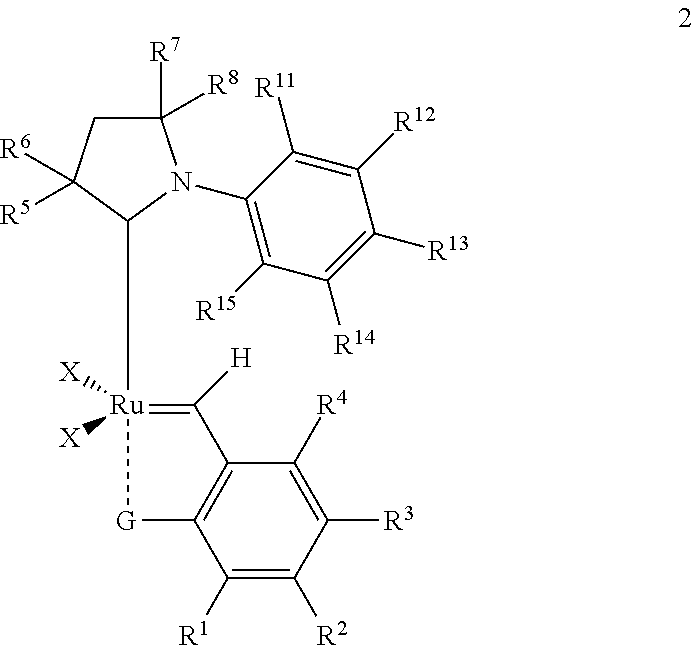
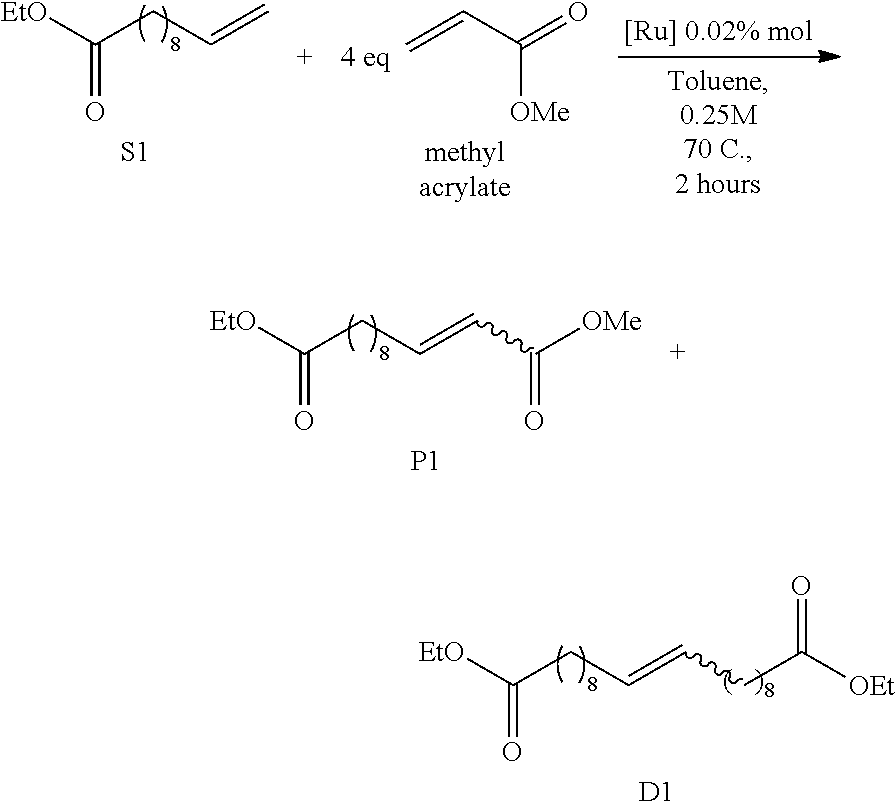

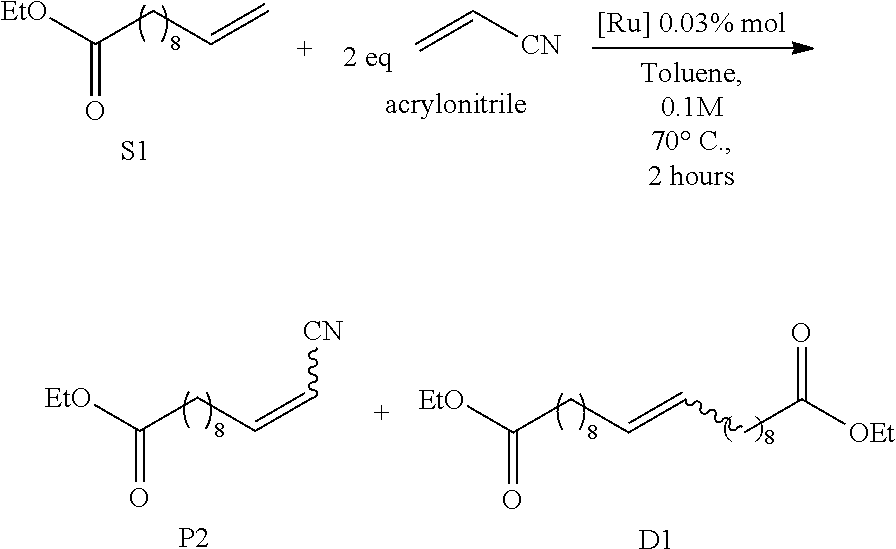
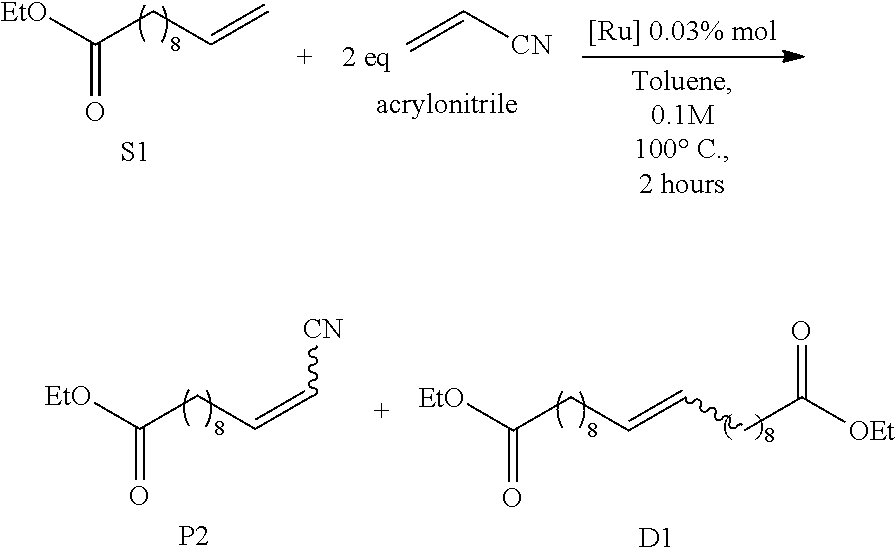
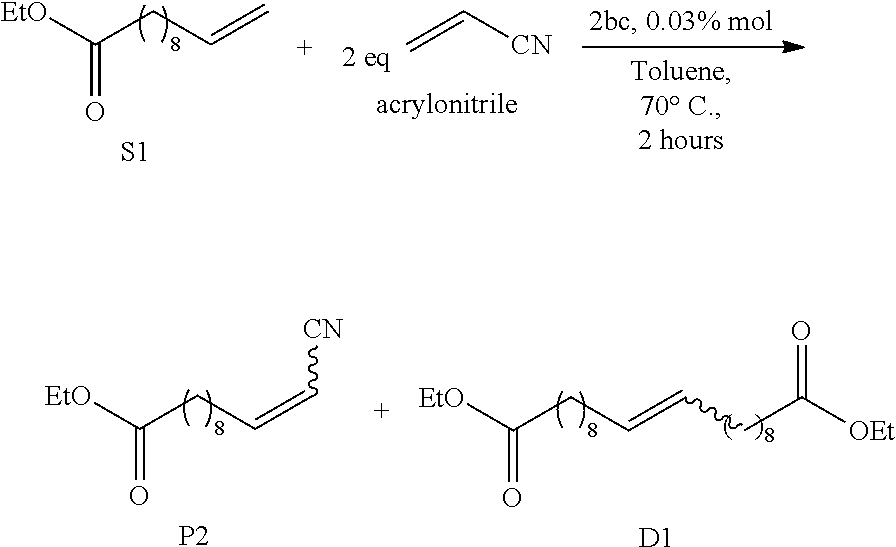
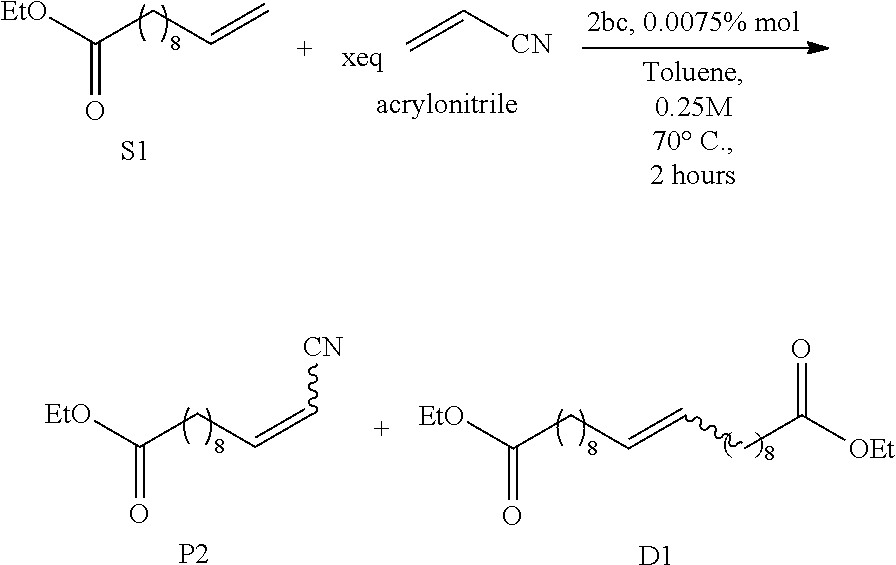
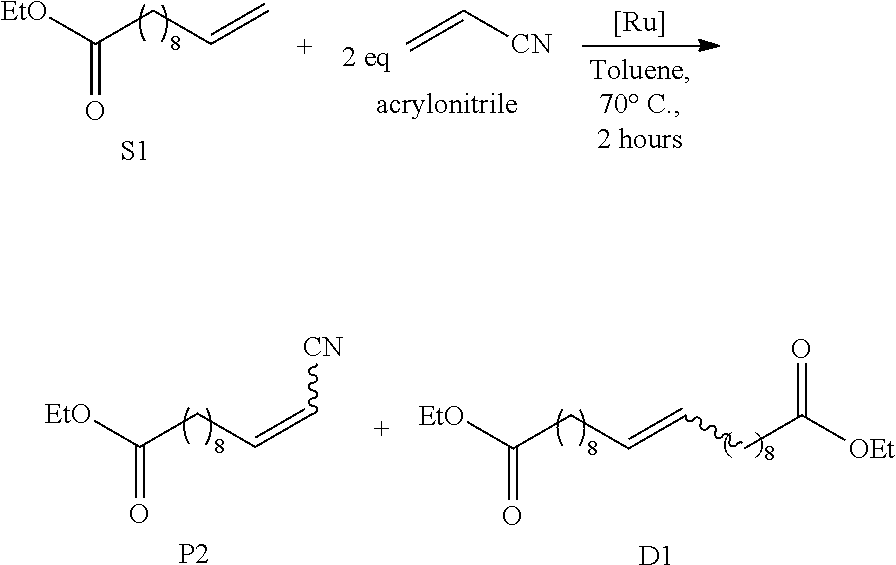


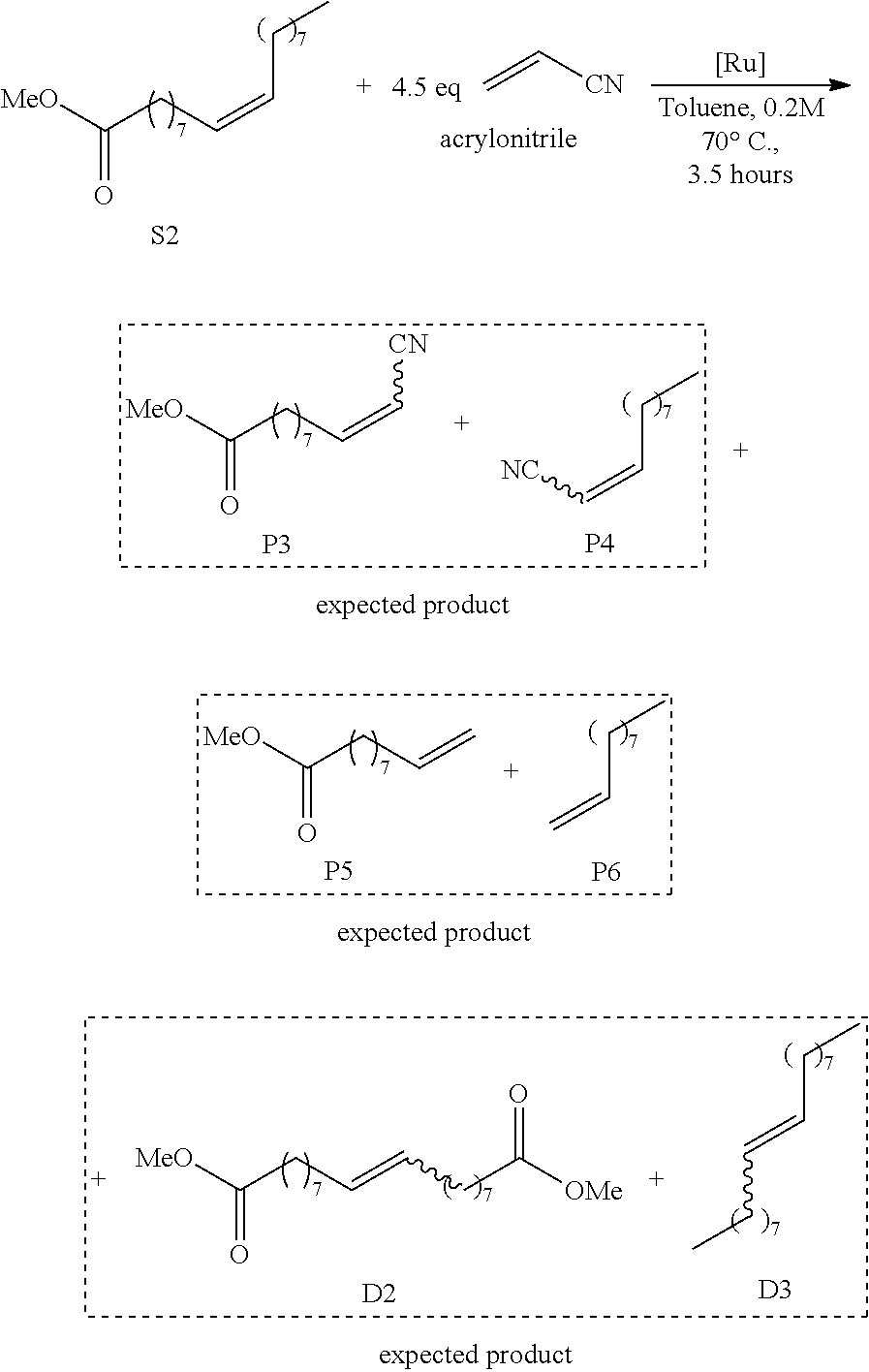
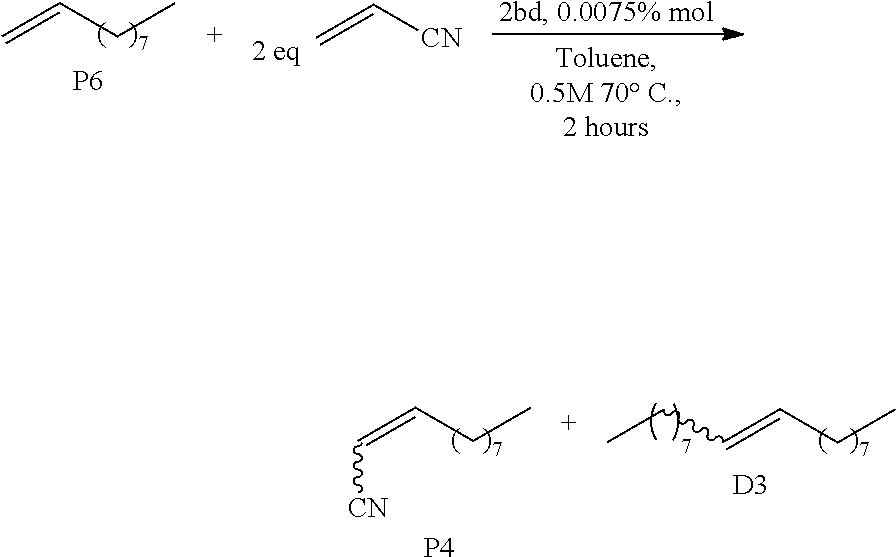

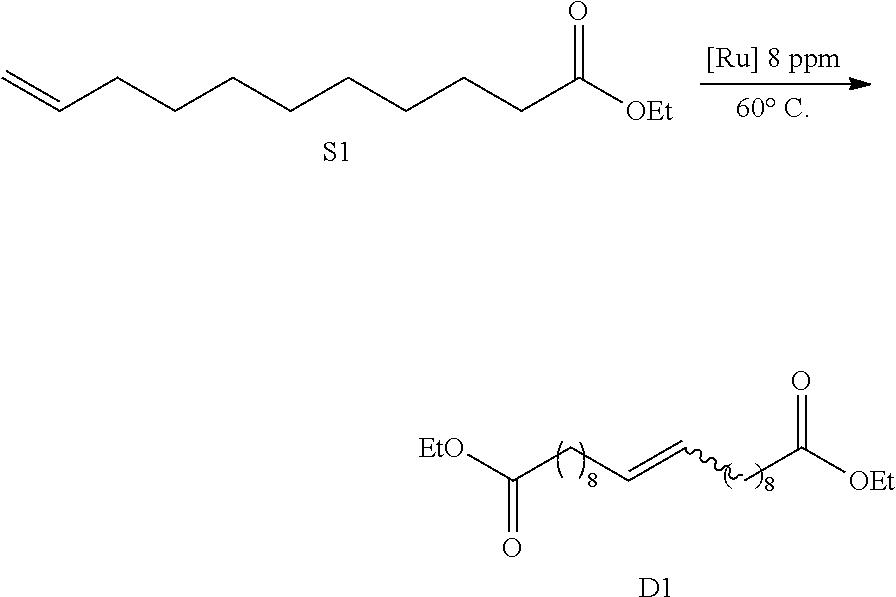



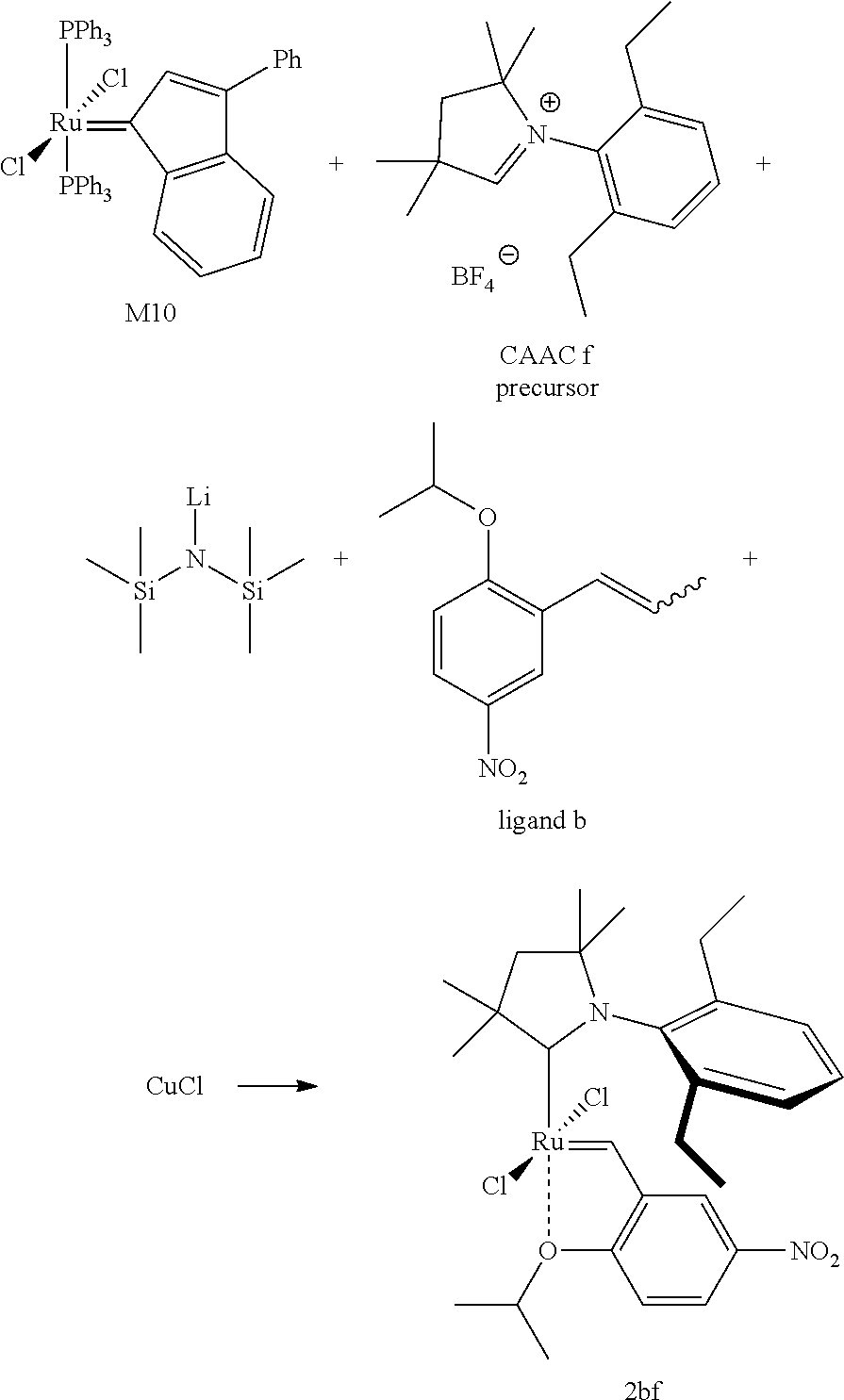
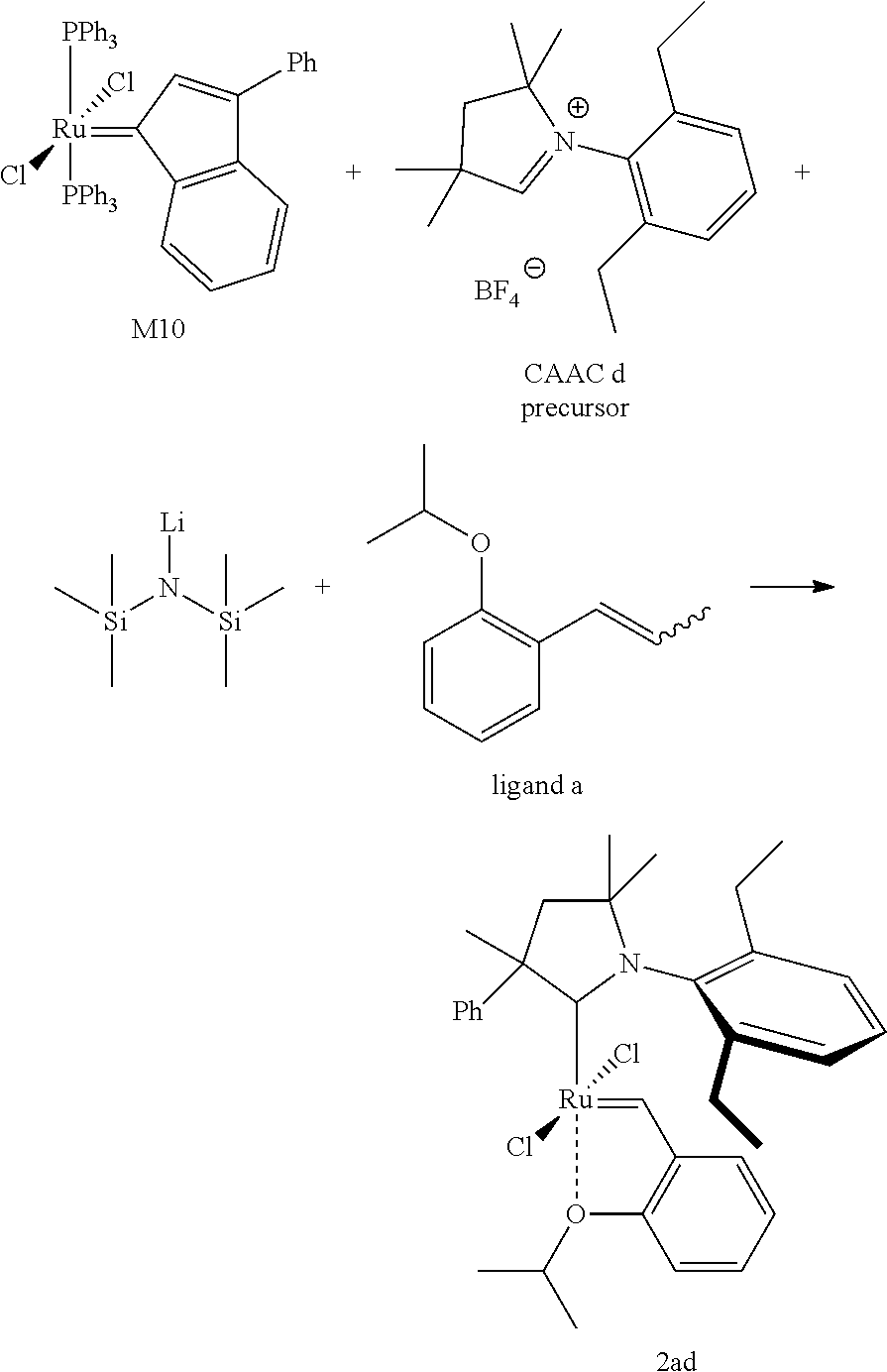

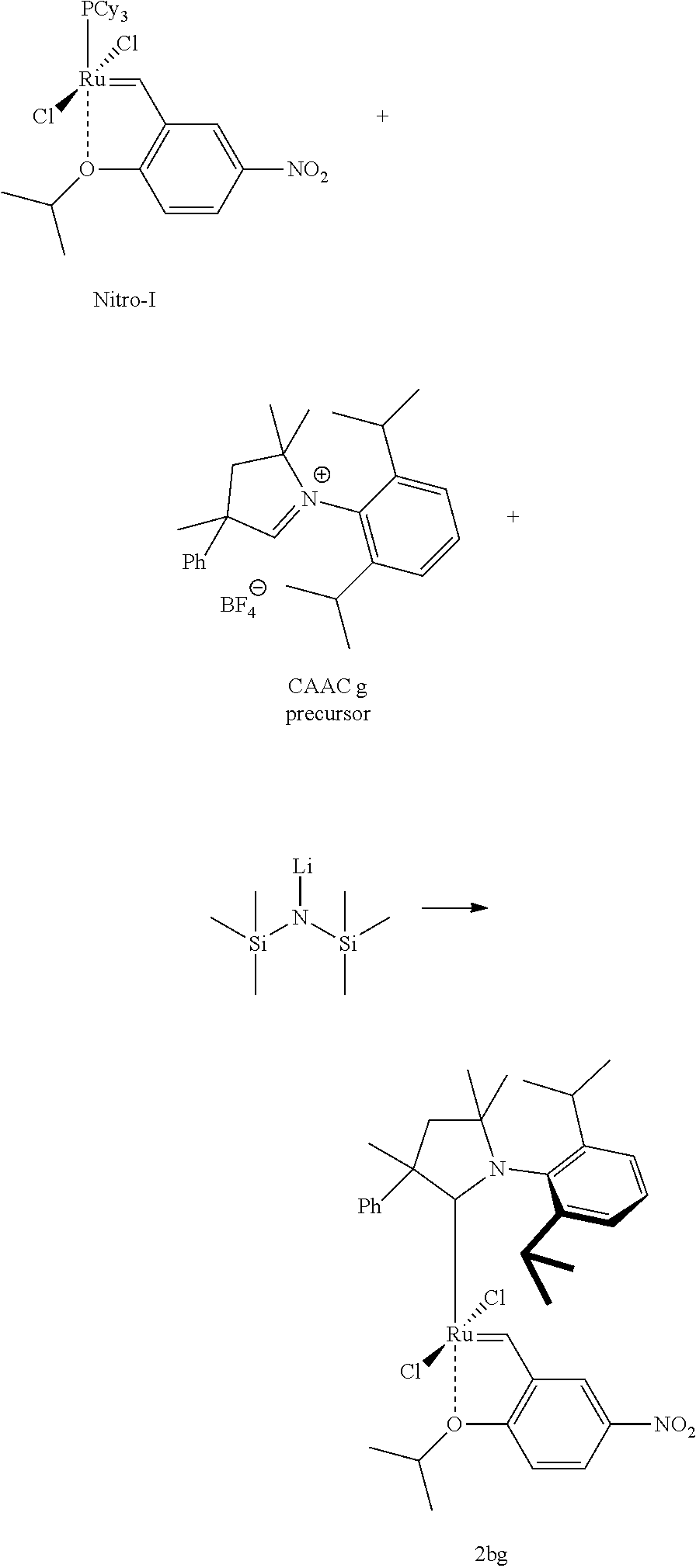




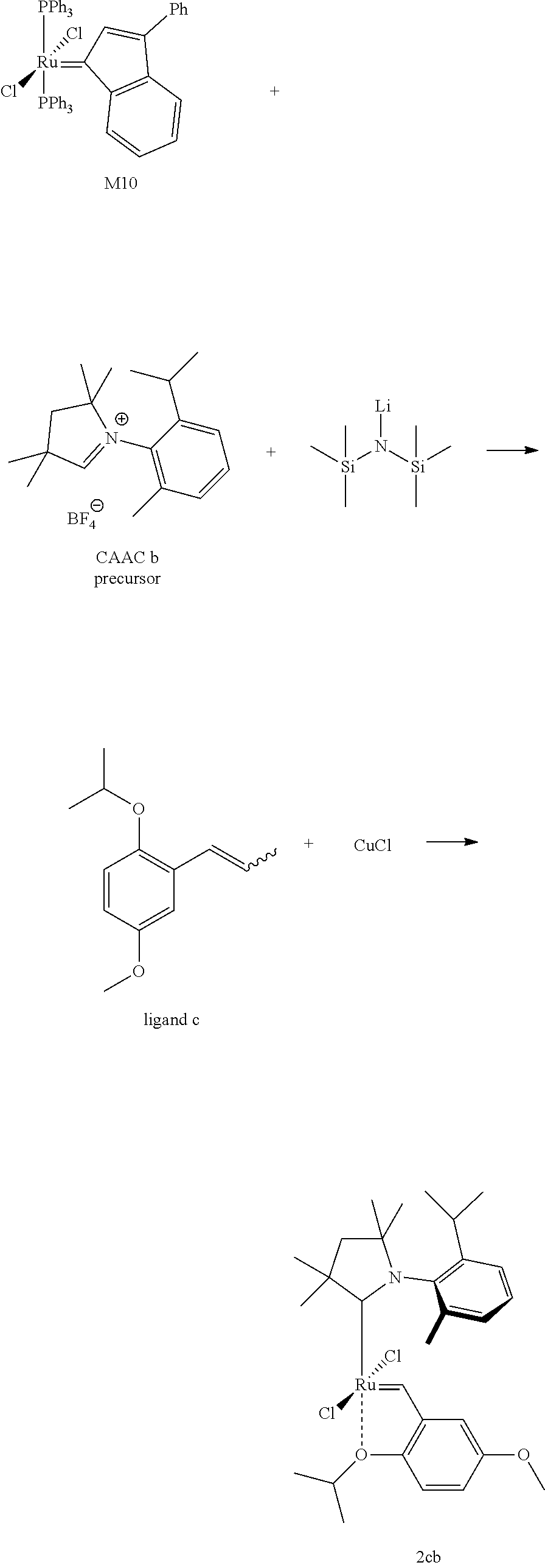
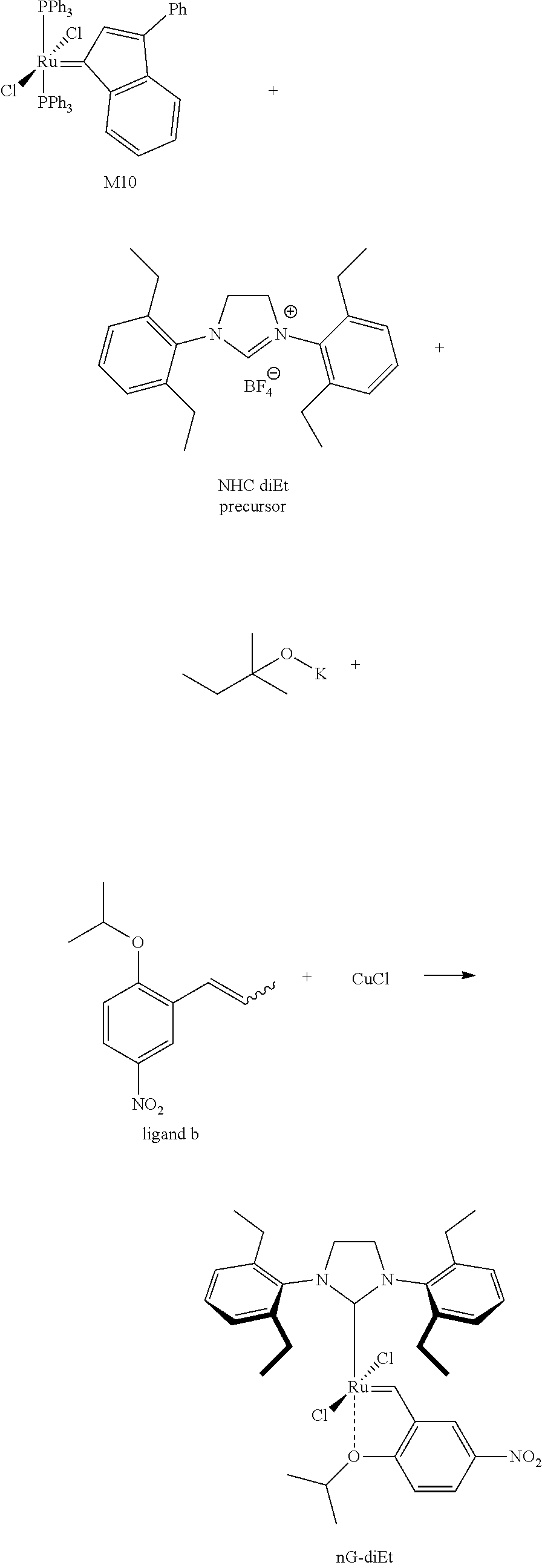
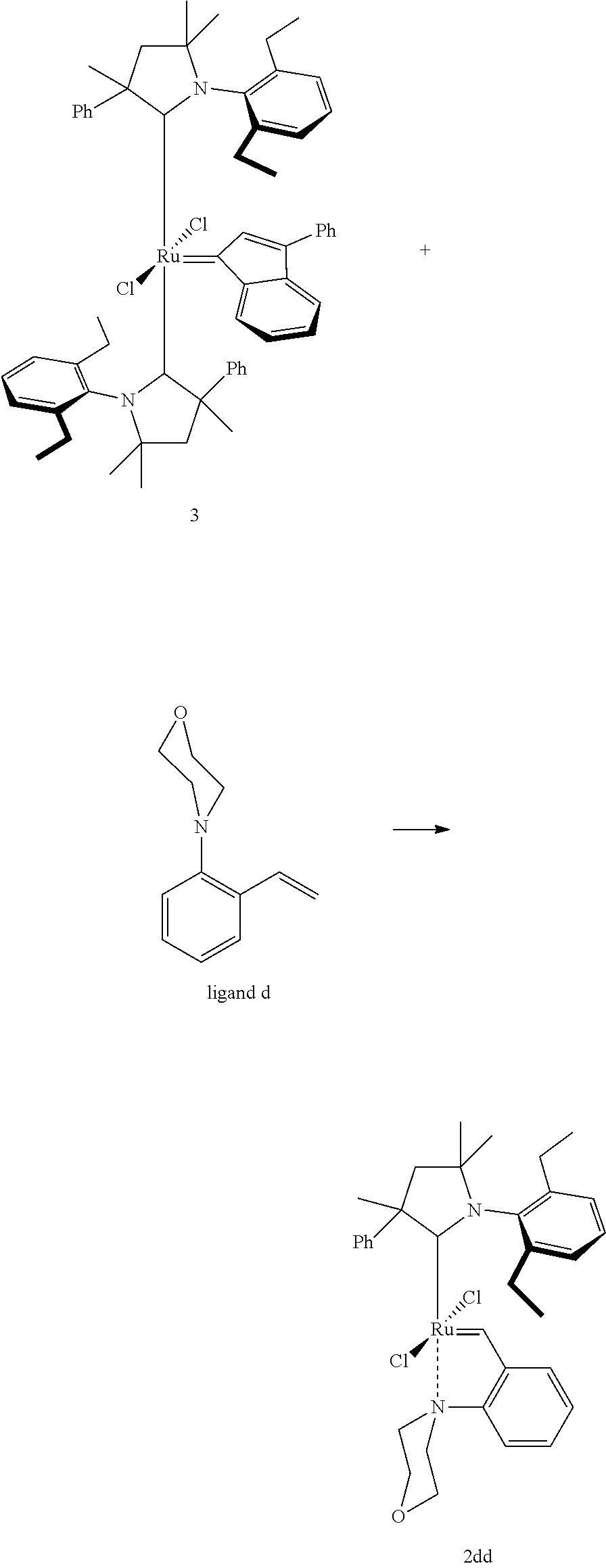
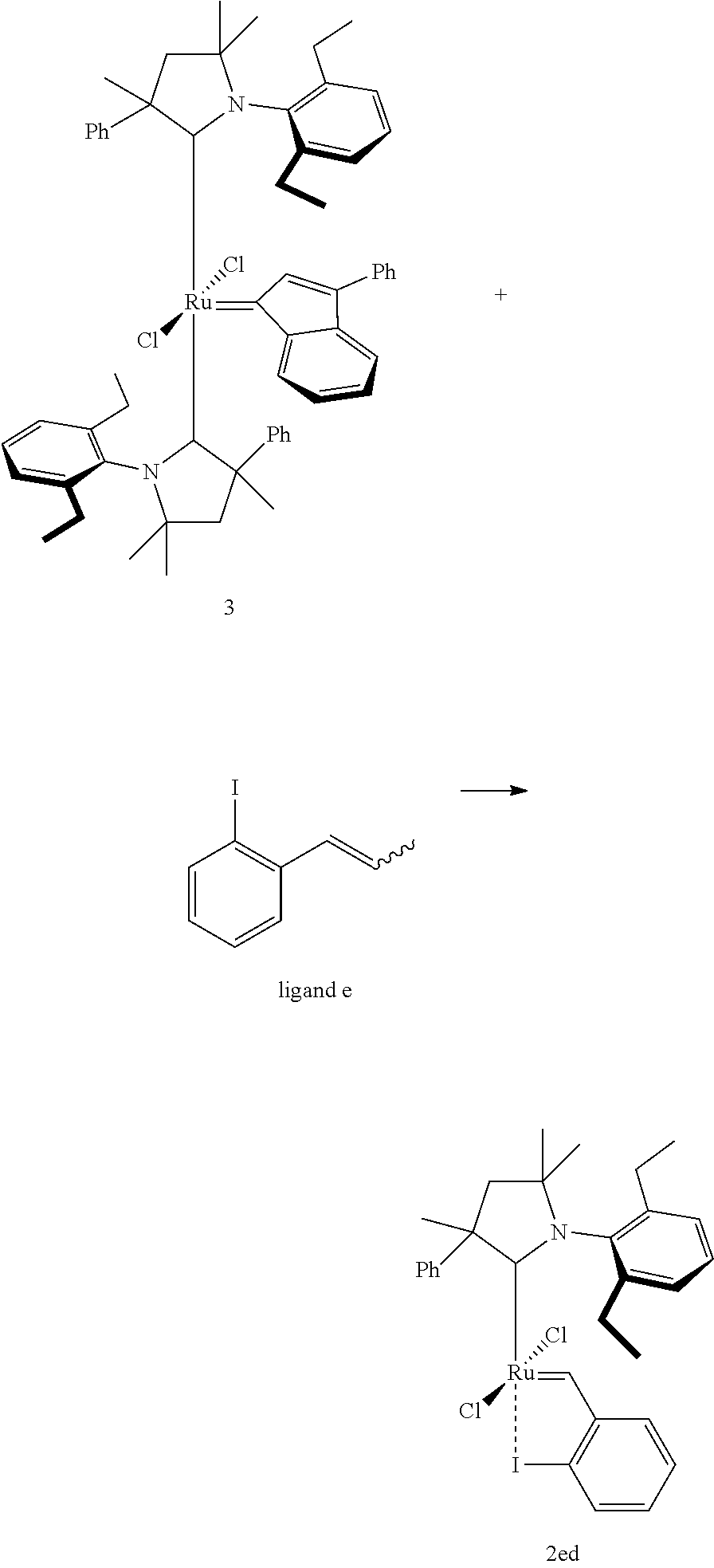


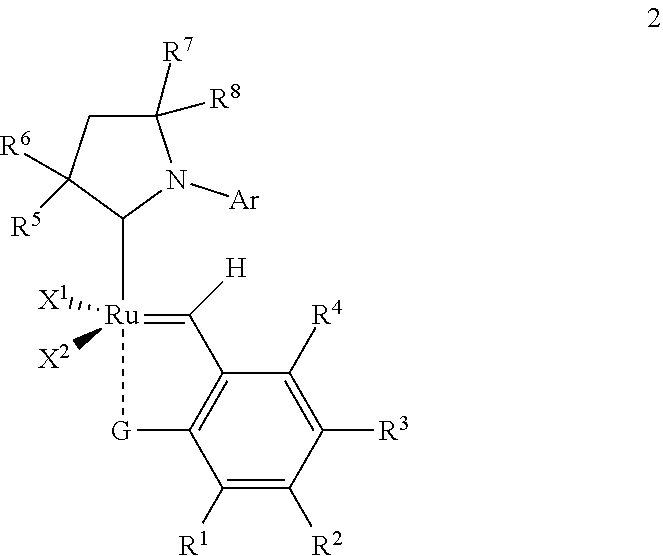
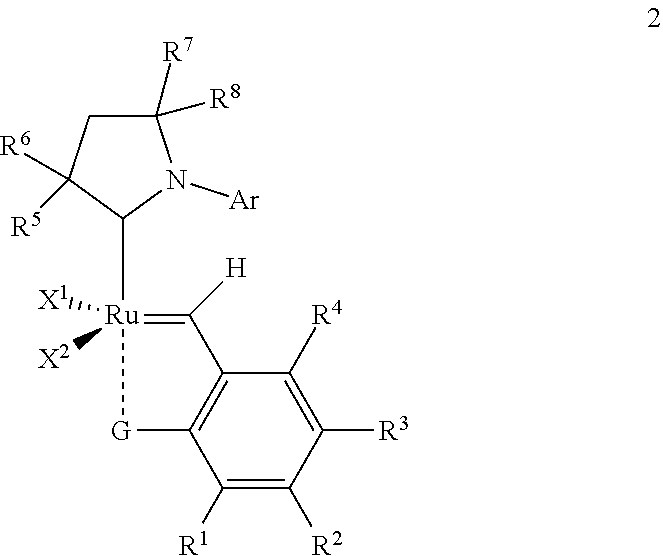
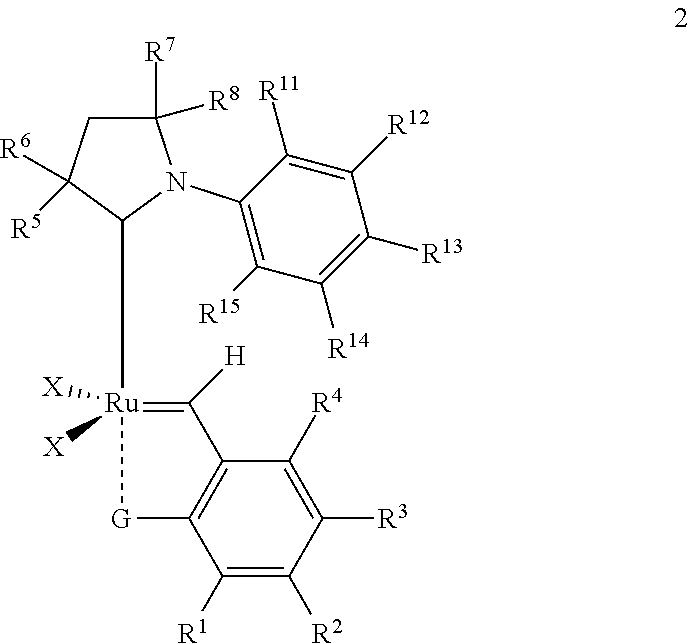
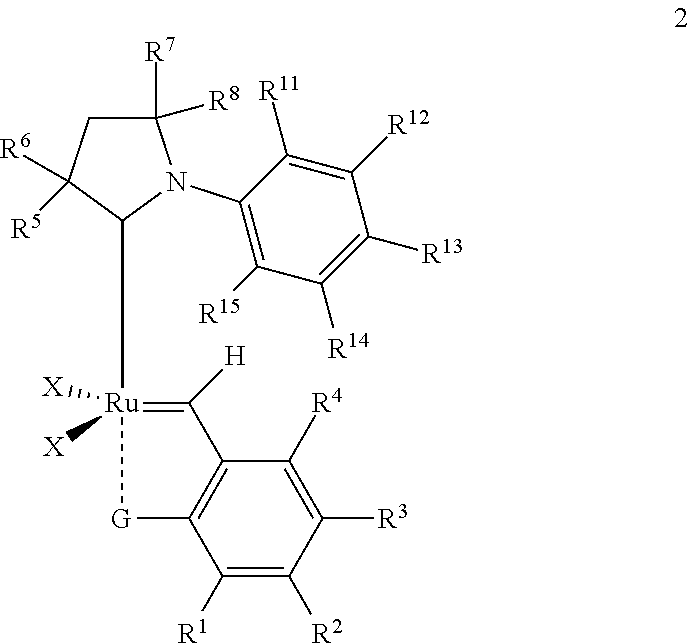

D00000
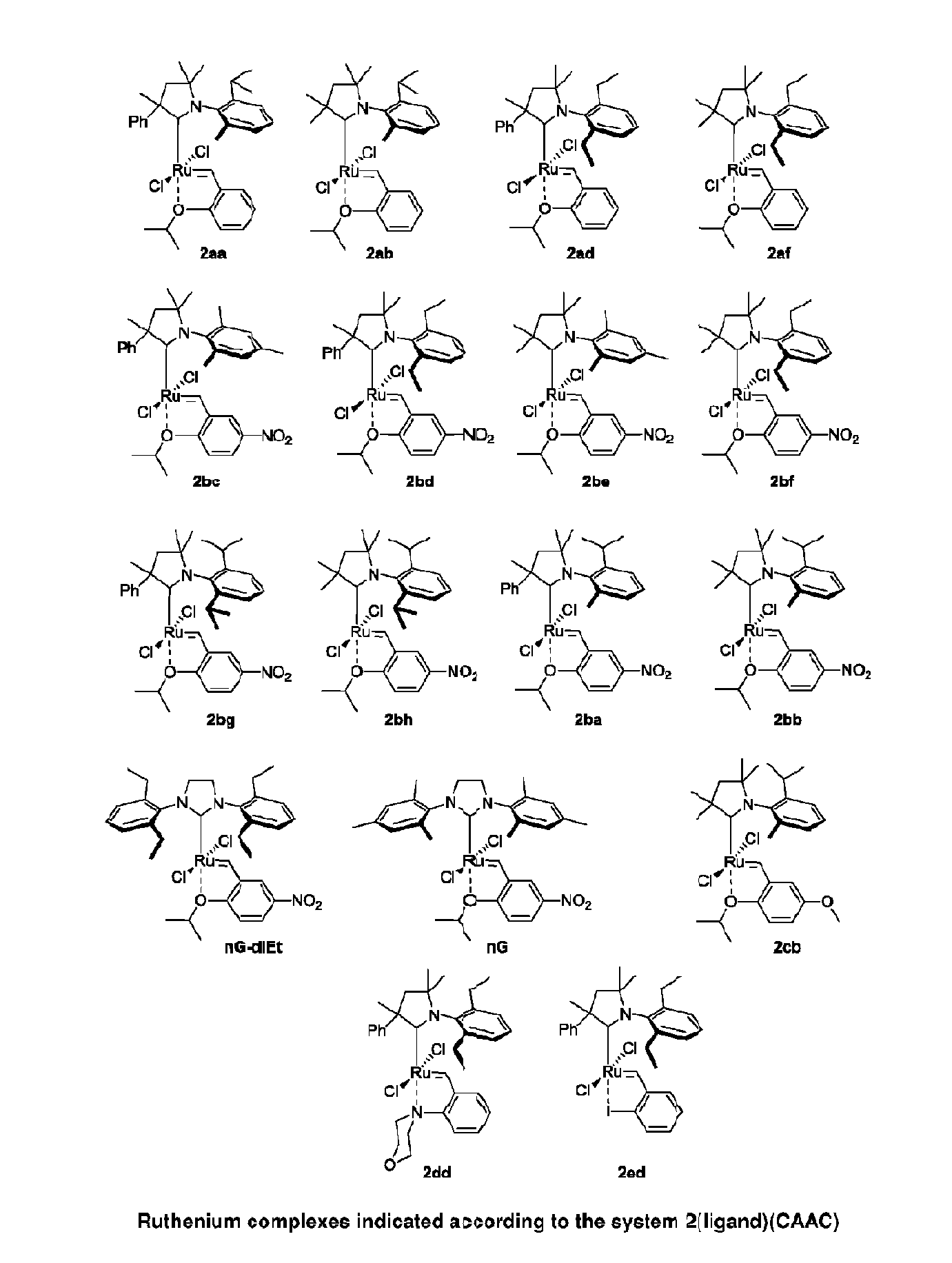
D00001



XML
uspto.report is an independent third-party trademark research tool that is not affiliated, endorsed, or sponsored by the United States Patent and Trademark Office (USPTO) or any other governmental organization. The information provided by uspto.report is based on publicly available data at the time of writing and is intended for informational purposes only.
While we strive to provide accurate and up-to-date information, we do not guarantee the accuracy, completeness, reliability, or suitability of the information displayed on this site. The use of this site is at your own risk. Any reliance you place on such information is therefore strictly at your own risk.
All official trademark data, including owner information, should be verified by visiting the official USPTO website at www.uspto.gov. This site is not intended to replace professional legal advice and should not be used as a substitute for consulting with a legal professional who is knowledgeable about trademark law.